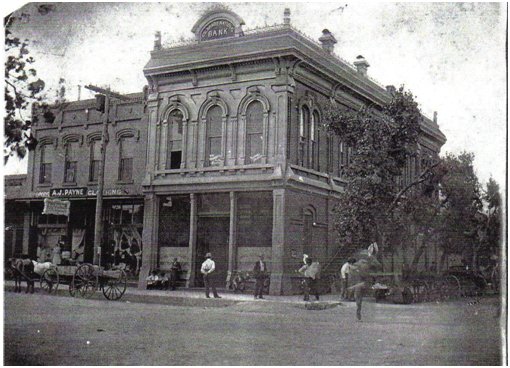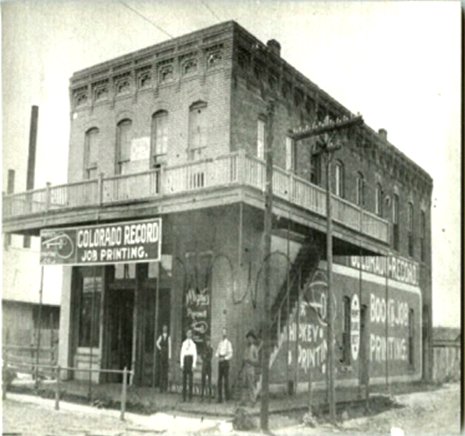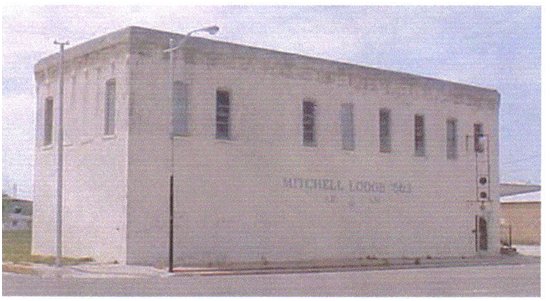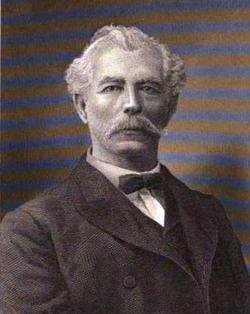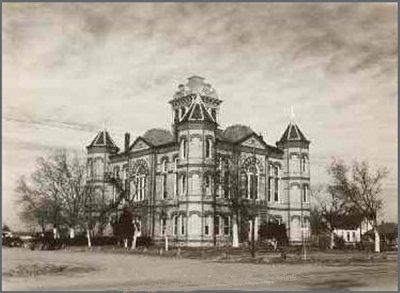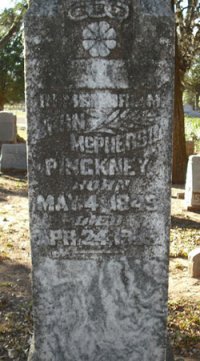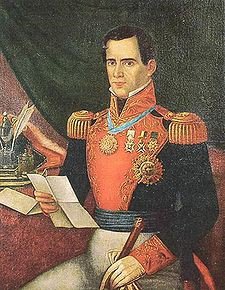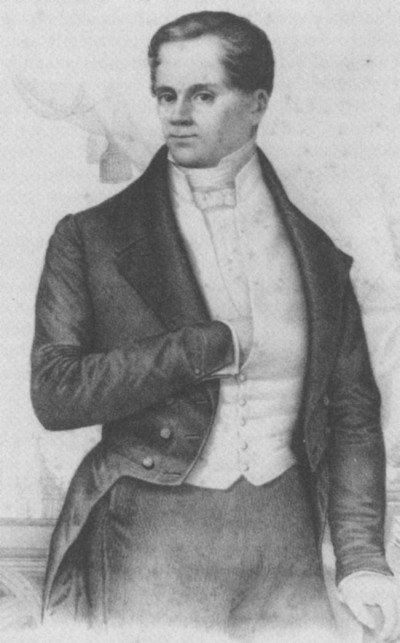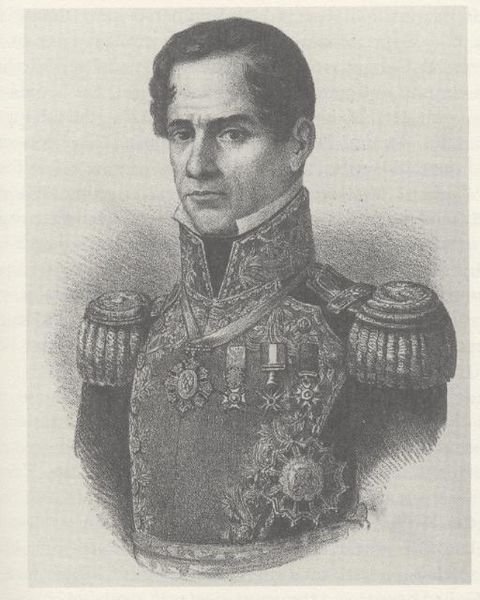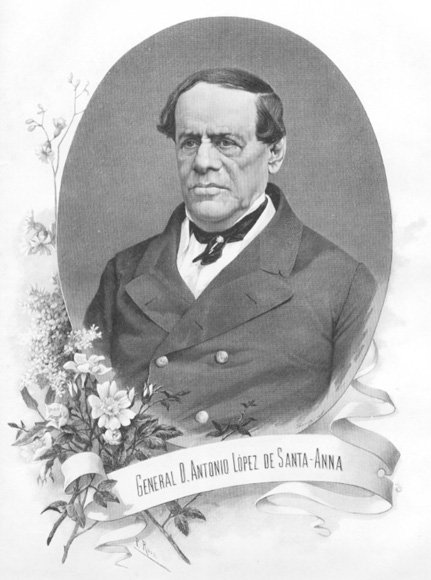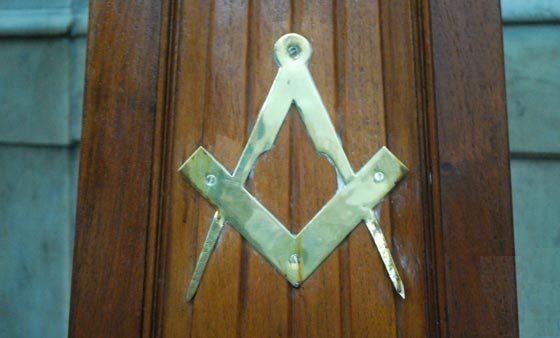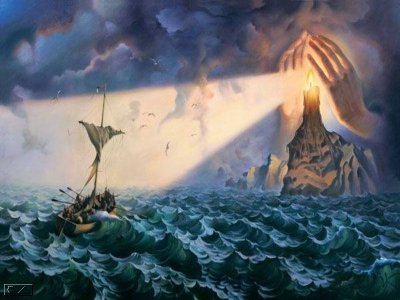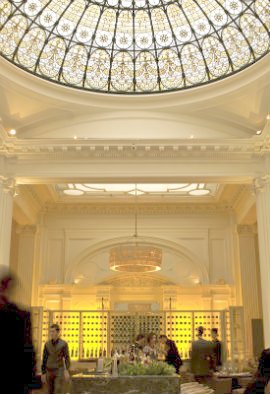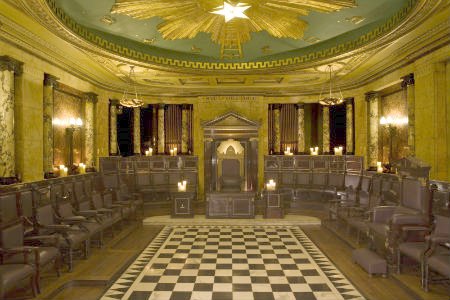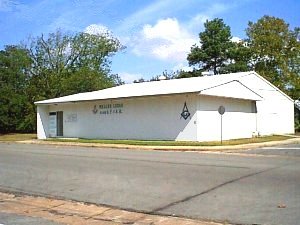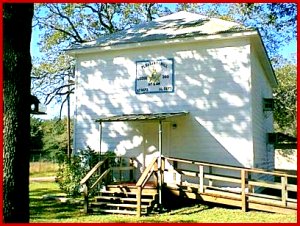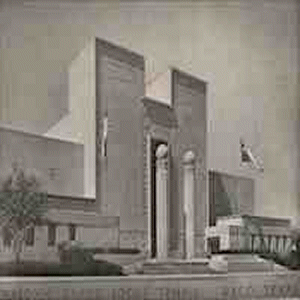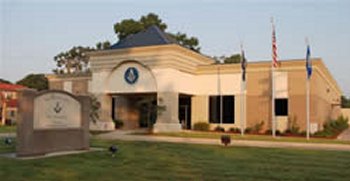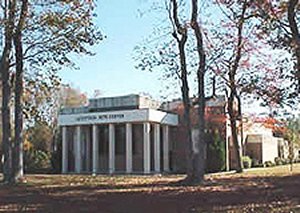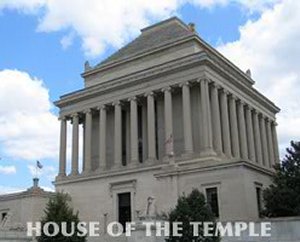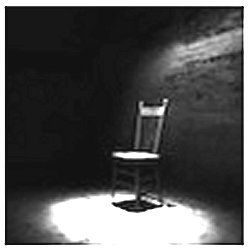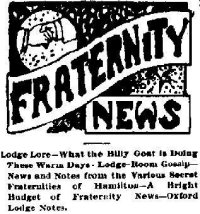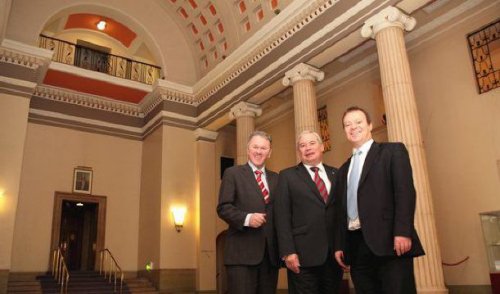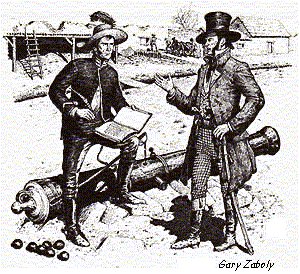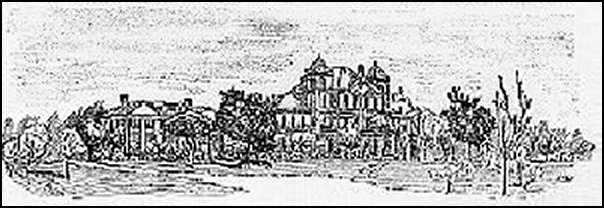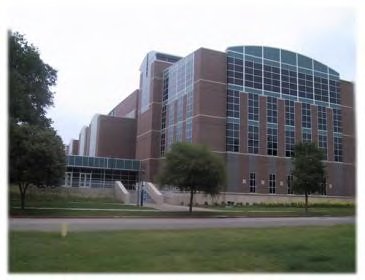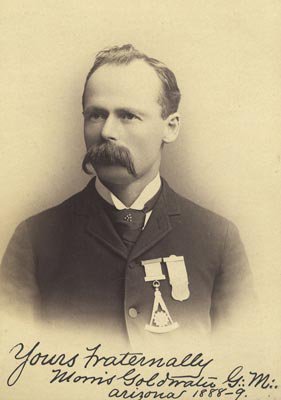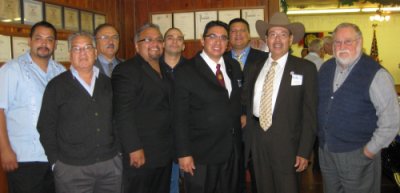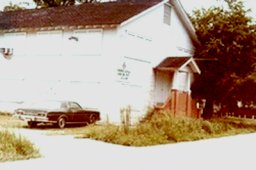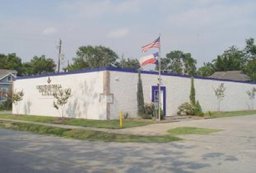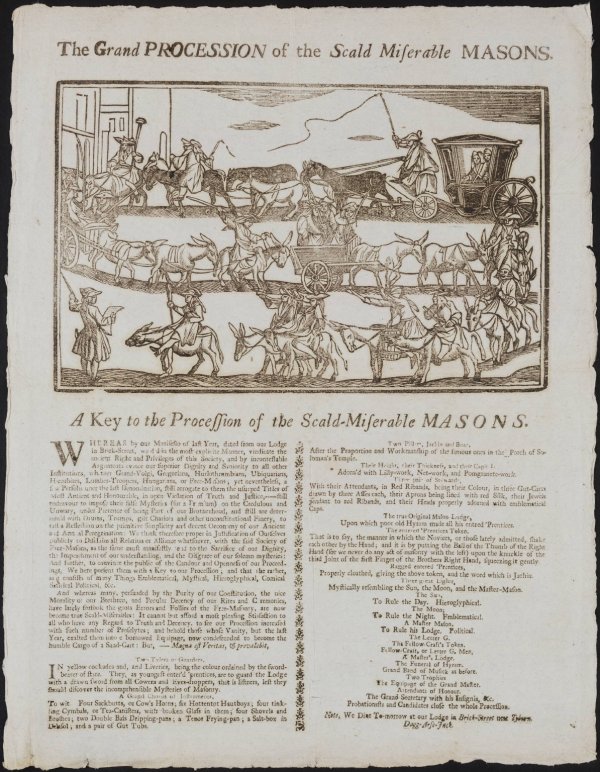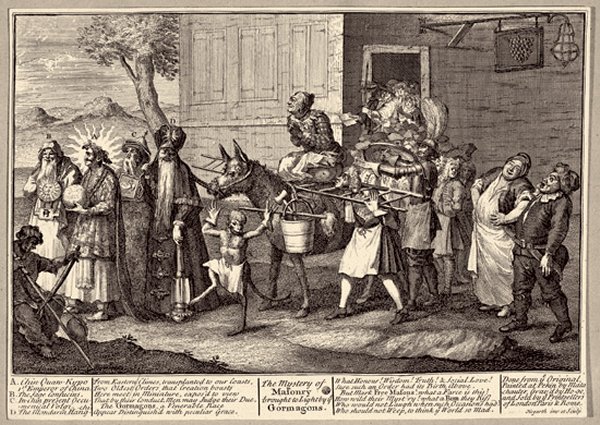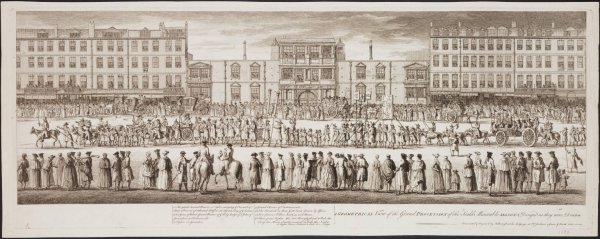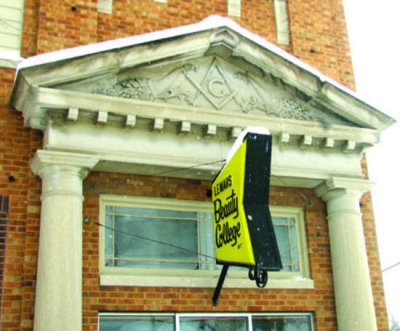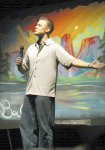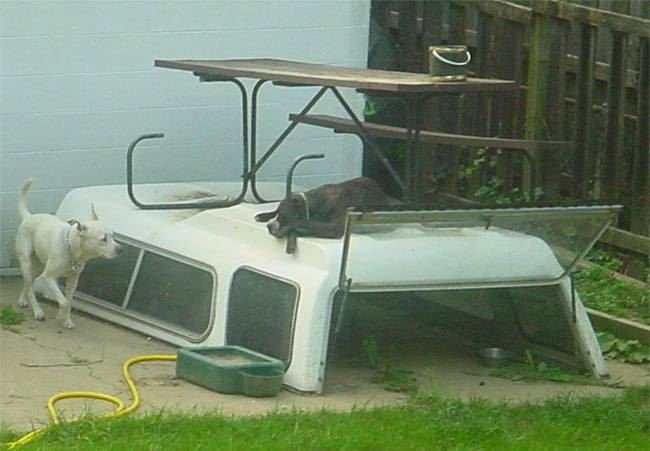
|
March 2011

Mitchell Lodge No. 563 AF & AM
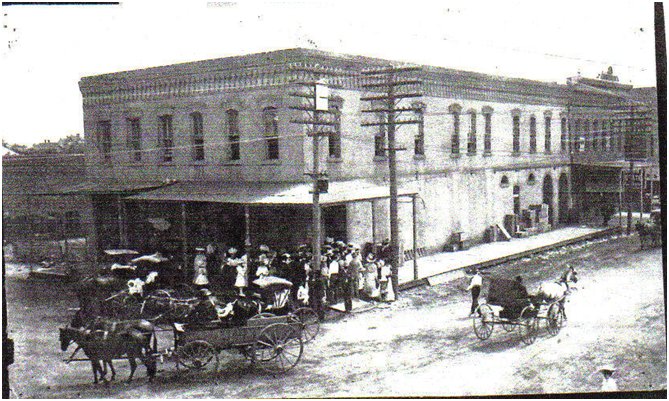 The first building occupied by Mitchell No. 563, North East Corner of Oak and Second Street, Colorado, Texas, Second Floor, December 2, 1882, lease was agreed with J. S. Johnston, for two years at $20.00 per month . March 2011 Mitc East Fork Lodge #650 AF & AM |
|
| ||||||
|
Located in Colorado City' Texas
The Beginning: Mitchell County, organized in 1876, was named for pioneer brothers Asa and Ira Mitchell, who were Master Masons from Illinois. Colorado was established as its county seat in 1881. According to Lodge history, a discussion on a downtown Colorado street in the Summer of 1882 among four niw residents (all Master Masons), R. H. Looney, John L. Doss, D. T'. Flughes and Joseph Adair lead to a meeting on June 23, 1882 with other known Masons interested in seeking a petition to form a new lodge. The Petition addressed to Most Worshipful Grand Master Thomas W. Matthews contained the signatures of the following fourteen Master Masons residing in Colorado at the time: Joe Adair, Sr., Will Aldridge, F. C. Bates, Wm. Howerton, B. M. Hughes, John S. Johnston, R. L. Looney, G. Alex Marten, I. W. Pearson, D. N. Quinn, O' F Rogers, Peter Turner and G. W. Waddell. On July 1, 1882 the petitioners traveled the seventy five miles to Abilene Lodge U.D to a stated meeting and after examination were found proficient in their knowledge of Masonry. Shortly thereafter, on August 25, 1882, Grand Master Matthews issued a Dispensation for the Colorado Masons to form and work as Mitchell Lodge U. D. The Dispensation was written and signed at Edom, Van Zandt County, Texas stating that Joe Adair would be the first Worshipful Master and D. N. Quinn, the first Senior Warden. Mitchell Lodge U. D. held its first stated meeting in "their Hall" in the town of Colorado, Texas, September 1, 1882, D. N. Quinn, Senior Warden, presiding. Worshipful Master protem. With twelve Master Masons present" they proceeded to elect and appoint appropriate officers of their new lodge and a committee to "arrange anti rooms, altar stands, etc. by their next meeting". On October 2, 1882 with Joe Adair, Worshipful Master presiding, three Petitions for the Degrees of Masonry were received. The first Entered Apprentice, John R. Adair was initiated on November 25, 1882. Other business during this meeting was to set the dues for $3.00 per year, set the Stated Meetings for the first Saturday of each month, selected John S. Johnston as the first "proxy" to Grand Lodge with an order to deliver the $25.00 cost of a Charter to the Grand Secretary in Houston. A Few Highlights of the first Decade of Mitchell Lodge:
April 7, 1883, the first Master Mason raised under Charter was Brother Charles Sanders. March 1, 1884, upon application, appearance and investigation of Brother Masons of the Big Spring, Texas area, permission was granted to form a Masonic Lodge, titled Staked Piains, William Hamerton, a member of Mitchell Lodge, was one of the petitioners for this new Lodge. May 10, 1884, Mitchell held its first Masonic trial for ”Un-Masonic Conduct”. May 19,1884, Mitchell recorded its first Masonic Funeral' Iune 27,1884, Mitchell leveled the first Cornerstone in the county for the Mitchell County Court House, R.W. DDGM C. K. Stribling presiding. December 5, 1885, Mitchell Members responded to monetary request in the aid for the relief of victims of the "Great Galveston Fire". January 1, 1887, Mitchell had its first Expulsion of a member, charged and found guilty of "Family Desertion". April 4, 1888, Mitchell received with honors" the new DDGM of the Masonic District 43, R.W. J. C. Kerr. April 5, 1890, three members of Mitchell Lodge, J. P. Skinner, Peter Engel, and T. J. Haught, all of Snyder Texas, appeared before the Lodge requesting permission to form a new Lodge in Snyder, titled Scurry Lodge. Their request was examined and approved. November 27, 1890. Mitchell laid the first Corner Stone on a Church, the Presbyterian Church, in Colorado, RW DDGM J. W. Germany of the 43rd Masonic District, presiding. June 6, 1891, Past Grand Master R. W. Norton Moses, present and Presiding the Lodge approves a motion to move to a new location, second floor of the Colorado National Bank, 2nd and Walnut. The first decade of Masonry in Mitchell County, Mitchell Lodge No. 563 performed 210 total ceremonies of the degrees in Masonry (98 Entered Apprentice" 60 Fellow Craft and 52 Master Masons, all of which were parent members of 563). Some started in their Masonry at Mitchell and then they would be compelled to relocate to another town to continue their vocation and hopefully their Masonic endeavors. The Lodge began with 22 Master Mason members in 1882 and in 1892 the membership of Master Masons was at 59. The highest accountability of members was in the reports of 1885, when there were reported 64 Master Mason members. The Continuation of Mitchell Lodge: On April 15, 1893, the Lodge was.ioined with the Order of The Eastern Star, Chapter 58, making a total of three organizations sharing the new Lodge Room; The Blue Lodge, the OES and the Royal Arch Chapter No. 175. January 10, 1903, the Lodge makes a donation for the construction of a statue of Stephen F. Austin, located at the State Capital building in Austin, Texas. The second home of Mitchell Lodge was the second floor of the Colorado National Bank located at 2nd and Walnut. Purchased on October 7, 1905 in a Sheriff s Sale for $5000 this building remains the home of Mitchell Lodge today. Originally the first floor was rented to various retail establishment' More recently it has undergone numerous renovations including moving the lodge room from the second to the first floor. August 4, 1904, the Lodge selected to exempt dues of all members who attain the age of sixty years. The Royal Arch Council No. 114 was chartered on December 3. 1907 and joined the other appendant bodies sharing the new Lodge room. WWI and WWII:
A Resolution of Mitchell Lodge which passed on May 5th, 1917, stated that all members of this Lodge who were serving in the US Military Service during the War were exempt from dues. Those who served were listed in the Annual returns as follows: H. H. Enderly, G. T. Adams, W. O. Jackson, D. S. Phoenix, Thomas J. Coffee, S. R. Coleman, Wallace Coereham, R. L. Phillips, W. C. Reese, H. C. Scott and Joe I{. Smoot.
|
|
| ||||||
Continued From Page III July 1, 1941. at the request of the Grand Lodge of Texas, Mitchell Lodge purchased the first of several $1,000 Defense Bonds. August 4, 1942, the Lodge agreed to donate $10.00 per month to the "Mitchell County War Chest". March 3, 1942, a motion was made and carried for all Lodge members serving in the Armed Forces were to be kept in good standing for the duration of the War. Twenty-one members of Mitchell Lodge served in WWII. To the Present: The Brethren of the lodge have been quick to respond those in need over the years- Records show donations being made to aid those suffering from the Galveston fire in 1885, to the relief of the victims of the Texas Coast Hurricane in 1900 and to aid those suffering in the Ohio floods of 1913. Donations were also made to the Home and School on a regular basis and to help Grand Lodge pay for the new Temple in Waco" Texas' Cornerstones were leveled for local schools, churches and government buildings with appropriate ceremony. Grand Masters and other dignitaries visited the lodge and members from surrounding lodges lent their support for the official visits adding to the numbers who greeted the Masonic officials and celebrated with barbeque dinners. Of note, a gathering in response to a radio broadcast from Waco made by Grand Master G. M. Crooker on July 5, T935, addressing the duties and responsibilities of Worshipful Masters attracted eighty-eight Brethren with sixty living outside of the Colorado City area. There have been many Brethren who celebrated membership in the Lodge with 40, 50, 60 and75 year anniversaries. And when there was dissention' as in whether or not to allow "chewing and smoking" in the lodge, a vote settled it. Brother Smith's conclusion from his book follows:
This concludes those historical moments of public interest, as recorded in the minutes of the Mitchell Lodge for 125 years existence in Colorado City. We now are looking forward to the next 125 years and what it will bring from those guys with the funny aprons.
| ||||||
|
The Day Six Shooter Junction Earned It's Name
Wrong Side To Tangle With In A Fight
In a special election to fill the unexpired term of Thomas H. Ball, a longtime Public official from Waller County, John McPherson Pinckney, was elected to the 58th Congress in 1903, and then reelected in 1904. Those who knew him in Congress called him quiet, but stern and resolute.
While the 19th Amendment, the Volstead Act, was not to be passed and ratified until 1919, many states passed their own prohibition laws much earlier and fanned the flames for a national consensus. In the climate underlying the shrill debate surrounding alcohol, Congressman Pinckney aligned himself firmly with Prohibition movement.
Witnesses gave conflicting accounts of what happened next, but reportedly a fight broke out and the Congressman jumped into the fray in attempt 1o help break up the melee. Revolvers were pulled and a hail of bullets cut down the unarmed Congressman, and his younger brother, Thomas. Within two minutes some 75 bullet holes riddled the walls of the courthouse. When the shooting stopped, both Pinckney and two other men lay dead.
Congressman Pinckney was very close with his brother Thomas, and Thomas had shadowed his brother and served him in several official capacities over the decades. Thomas' loyalty ultimately, cost him his life.
One account of events that day reported that the shooter himself was among the dead, but vastly differing accounts make certainty as to what transpired impossible. Roland Brown was arrested and tried for the murder of Congressman Pinckney. In a jury trial, Brown was acquitted.
Fellow Democratic members of Congress eulogized the slain Congressman Pinckney months later from the floor of the House. Members from many states offered kind remembrances' respectful comments and recalled his arduous military service. A common theme throughout most of these eulogies was Pinckney's mild demeanor, diligent work ethic, courteous nature and upright behavior.
Pinckney was born in 1845 in Field's Store, in then Grimes County, in the waning months of the Republic of Texas. In 1861, exhibiting the courage and conviction he would display throughout his life, Pinckney enlisted in the Confederate Army at age 16, joined in the adventure by his brother Thomas' This would be the first time these brothers stepped forward together to serve Texas - an allegiance to each other that would one day Prove fatal.
Remarkably, the Pinckney brothers survived four years of deadly fighting during the Civil War with the renowned company G, 4th Texas Infantry. Civil War historians single out the 4'h Texas as likely the most celebrated of all Confederate units - a unit that Gen. Robert E. Lee would personally call on time and again in fighting from Second Manassas, Eltham's Landing, The Wilderness, Sharpsburg, Gettysburg and Chickamauga. Haggard, tired and threadbare, the 4th Texas fought until the end and was present at Lee's surrender at Appomattox in April 1865.
The Pinckneys came home after the war and shortly John began studying the law. Being admitted to the bar in 1875 was a springboard for John, and he was soon Seiving as justice of the peace. He was elected district attorney in 1890, where he served until 1900 when he was elected county judge, the office he held when elected to Congress.
Congressman Pinckney was buried in the Hempstead City cemetery the services conducted by a Baptist minister with local Masonic members offering rites.
Pinckney is one of only six members of Congress to die a violent death while serving in office.
By Reynolds Cushman, a former political reporter in Austin and Washington, D.C., now lives in Hempstead.
|
|
| ||||||
|
Antonio López de Santa Anna
Why write a history of Santa Anna, you may ask. Like it or not, General Santa Anna is single handedly responsible a very large part of Texas history and was said to be a Freemason. If it wasn't for him we could all still be speaking Spanish instead of English.
"F. "Guz" Guzman"
In 1811, Santa Anna was wounded in the left arm by a native Chichimec arrow during the campaign in the town of Amoladeras, in the state of San Luis Potosí. In 1813 He served in Texas against the Magee-Gutiérrez expedition of 1812-13 was an early filibustering expedition against Spanish Texas. And, he also served at the battle of Medina, about twenty miles south of San Antonio on August 18, 1813 It. was the bloodiest battle ever fought on Texas soil. The battle was fought. Santa Anna in was cited for bravery after the battle. He spent the next several years building Indian villages and in occasional campaigns, while he acquired debts, some property, and promotions. In 1820 he was promoted to brevet captain, and he became a brevet lieutenant colonel the following year. His job consisted mainly of occasional campaigns to suppress Native Americans or to restore order after a tumult had begun. Mexico reached Oregon in the north and Panama in the south. It was a territory too vast for the Spanish Crown to control.
In 1821, Santa Anna declared his loyalty for "El Libertador”, Agustín de Iturbide and rose to prominence by quickly driving the Spanish forces out of the vital port city of Veracruz. That same year. Iturbide rewarded him with the rank of brigadier general. Santa Anna, with his important rank exploited his situation for personal gain. He acquired a large hacienda and at the same time continued his gambling. Santa Anna was never
really obedient to Iturbide and in December 1822 Santa Anna broke with Iturbide over a series of personal grievances, and he called for a republic in his Plan of Casa Mata in December 1822. Santa Anna’s normal loyalty would be to ally with the wealthy and privileged, but his immediate concern was to be on the winning side in any battle. Switching allegiances never troubled him. Santa Anna declared himself retired, "unless my country needs me".
In 1822 Santa Anna went over to the camp of military leaders supporting the plan to overthrow Iturbide. In December Santa Anna and General Guadalupe Victoria signed the Plan de Casa Mata to abolish the monarchy and transform Mexico into a republic. In May 1823, following Iturbide's resignation, Victoria became the first president of Mexico. Assistance provided by Santa Anna, in the overthrow of Iturbide gave the other leaders reason to trust him, despite his well known propensity for switching sides in an opportunistic manner.
Santa Anna married Inés García in 1825 and fathered four children—Guadalupe,
Maria del Carmen, Manuel and Antonio. One month after García's death in 1844, the
50-year-old Santa Anna married 15-year-old María Dolores de Tosta. The couple
rarely lived together, with Tosta residing primarily in Mexico City. While they were married
until the end of his life they rarely lived together. They had no children, leading biographer
Will Fowler to speculate that the marriage was either primarily platonic or that
Tosta was infertile.[ Several women claimed to have born Santa Anna illegitimate children,
and in his will Santa Anna acknowledged four: Paula, Merced, Petra, and Jose.
Biographers have identified three more: Pedro Lopes de Santa Anna, Angel and
Agustina Rosa Lopez de Santa Anna.
In 1828, Santa Anna, Vicente Guerrero, Lorenzo Zavala and other politicians staged a
coup against the elected President Manuel Gómez Pedraza. On December 3, 1828
the army shelled the National Palace, the election results were annulled and Guerrero
took over as president.
In 1829, Spain made its final attempt to retake Mexico in Tampico
with an invading force of 2,600 soldiers. Santa Anna marched
against the Barradas Expedition with a much smaller force and defeated
the Spaniards, many of whom were suffering from yellow
fever. The defeat of the Spanish army not only increased Santa
Anna’s popularity but also consolidated the independence of the
new Mexican republic. Santa Anna was declared a hero, and from
then on he styled himself "The Victor of Tampico" and "The Savior
of the Motherland". His main act of self-promotion was to call himself
"The Napoleon of the West". He was a devoted collector of Napoleonic
artifacts, and although his nickname was "The Eagle."
Santa Anna considered himself "Napoleon of the West" after the
Telegraph and Texas Register referred to him as such.
Several states, including Coahuila y Tejas (which was to become the Republic of
Texas), went into open rebellion and several of these states formed their own governments,
the Republic of the Rio Grande, the Republic of Yucatan, and the Republic of
Texas, but only the Texans defeated Santa Anna and retained their independence).
Their fierce resistance was possibly fueled by reprisals Santa Anna committed against
his defeated enemies.[3] The New York Post editorialized that "had [Santa Anna]
treated the vanquished with moderation and generosity, it would have been difficult if
not impossible to awaken that general sympathy for the people of Texas which now
impels so many adventurous and ardent spirits to throng to the aid of their brethren".
After two hours of combat, on May 12, 1835, the Santa Anna's "Army of Operations"
defeated the Zacatecan militia and took almost 3,000 prisoners. Santa Anna allowed
his army to ransack Zacatecas for forty-eight hours. After defeating Zacatecas, he
planned to move on to Coahuila y Tejas to quell the rebellion there, which was being
supported by American settlers (AKA "Texians").
Like other states discontented with the central Mexican authorities,
the Texas department of the Mexican state of Coahuila y
Tejas went into rebellion in late 1835 and declared its self independent
on March 2, 1836. Santa Anna marched north to bring
Texas back under Mexican control. On March 6, 1836, at the
Battle of the Alamo, Santa Anna's forces killed 187-250 Texan
defenders and later executed over 350 Texan prisoners at the
Goliad Massacre (March 27, 1836).
Following the defeat, the Texans were reorganized under Sam
Houston and Santa Anna’s army was defeated by Houston's soldiers
at the Battle of San Jacinto on April 21, 1836, with the
Texan army shouting "Remember Goliad, Remember the
Alamo!" A small band of Texan forces captured Santa Anna,
dressed in a dragoon private's uniform and hiding in a marsh,
the day after the battle on April 22.
When French forces landed in Veracruz, Mexico In 1838, Santa Anna discovered a
chance to redeem himself from his Texan loss,. The Mexican government gave Santa
Anna control of the army and ordered him to defend the nation by any means necessary.
Santa Anna was hit in the leg and hand by cannon fire. His ankle was shattered
and this resulted in the amputation of his leg, which he ordered buried with full military
honors. Santa Anna famously used a cork leg after the amputation. Despite Mexico's
capitulation to French demands, Santa Anna was able to use his wound to re-enter
Mexican politics as a hero. He never allowed Mexico to forget him and his sacrifice in
defending the fatherland.
Soon after, Santa Anna was once again asked to take control of the provisional government
as Bustamante's presidency turned chaotic. Santa Anna accepted and became
president for the fifth time. His rule was even more dictatorial than his first administration.
Anti-Santanista newspapers were banned and dissidents jailed. Then, in
1842, a military expedition into Texas was renewed, with no gain but to further persuade
the Texans of the benefits of American annexation.
His demands for ever greater taxes aroused ire, and several
Mexican states simply stopped dealing with the central
government, Yucatán and Laredo going so far as to declare
themselves independent republics. With resentment ever
growing against the president, Santa Anna once again
stepped down from power. Fearing for his life, Santa Anna
tried to elude capture, but in January 1845 he was apprehended
by a group of Indians near Xico, Veracruz, turned
over to authorities, and imprisoned. His life was spared, but
the dictator was exiled to Cuba.
|
|
| ||
|
In 1846, the United States declared war on Mexico. Santa
Anna wrote to Mexico City saying he no longer had aspirations
to the presidency, but would eagerly use his military
experience to fight off the foreign invasion of Mexico as he
had in the past. President Valentín Gómez Farías was desperate
enough to accept the offer. Meanwhile, Santa Anna had secretly been dealing
with representatives of the United States, pledging that if he were allowed back in Mexico
through the U.S. naval blockades, he would work to sell all contested territory to the
United States at a reasonable price. Once back in Mexico at the head of an army,
Santa Anna reneged on both of these agreements. Santa Anna declared himself presi-
dent again and unsuccessfully tried to fight off the United States invasion.
Despite his generous payoffs to the military for loyalty, by 1855 even his conservative
allies had had enough of Santa Anna. That year a group of liberals led by Benito
Juárez and Ignacio Comonfort overthrew Santa Anna, and he fled back to Cuba. As
the extent of his corruption became known he was tried in absentia for treason and all
his estates confiscated. He then lived in exile in Cuba, the United States, Colombia,
and St. Thomas.
In 1874 he took advantage of a general amnesty and returned to Mexico. Crippled and
almost blind from cataracts, he was ignored by the Mexican government when the anniversary
of the Battle of Churubusco occurred. Santa Anna died in Mexico City two
years later, on June 21, 1876, penniless and heartbroken.
Mexican General Santa Anna, A Freemason?
Joseph E. Bennett in his book, "Masons Along the Rio Bravo" wrote this about Santa
Anna: "During this tour of duty in Texas, at San Antonio de Bexar as a young military
officer of 21 to battle troublesome rebels for the next seven years Santa Anna is
thought to have become a Scottish Rite (Escoceses) Mason. His Masonic affiliations
were tenuous to say the least. No Body or Lodge has ever acknowledged Santa Anna
as a member. His claim to membership actually depends on the apron he claimed his
own, plus the incidents in which he identified himself by the signs of recognition in use
at that time. If indeed Santa Anna was a Freemason, he was the most reprehensible
example of what one should be."
Compiled from Wikipedia, Texas State Library and Archives Commission, Sons Of
Dewitt Colony and Handbook of Texas On-Line, by John "Corky" Daut, P.M. Waller
Masonic Lodge #808,
| ||

By Ian F. Thurn
Predating Argentina itself, the Freemasons have been in existence since 1795
Freemasonry in Buenos Aires was started with the consecration of a “Logia Independencia” in 1795 consisting of young intellectuals mostly with higher European degrees. Some of the most prominent members were Juan José Castelli, his cousin Manuel Belgrano, Juan José Paso, Feliciano Chiclana, Matías Irigoyen, Nicolás Rodríguez Peña, Hipólito Vieytes, Juan Larrea, Domingo Matheu and Antonio Luis Berutti.
Going forward in time and leading up to May 25, in 1808 Don José de San Martín joined his first lodge, the “Logia Integridad” in Cadiz, where the Worshipful Master of the lodge was General Francisco Solano, Captain General of Andalucia. It was at this time that San Martin, who was only a junior Mason at the time, met Lord Mac Duff, a noble Scotsman, who was plotting the liberation of South America.
San Martín traveled to England where he was put into contact with Alvear, Zapiola, Berro and Guido who formed part of the Lodge Lautaro created by Francisco de Miranda, who along with Bolívar, were already fighting in Venezuela for its liberation.
On March 9, 1812 San Martín arrived in Buenos Aires on board the Royal Navy Frigate George Canning direct from London, accompanied by a group of high ranking military personnel such as Chilavert, Zapiola, Carlos de Alvear, Arellano and Baron Olambert.
It is interesting to note that the First Triumvirate in 1811, the Second in 1812, the Declaration of Independence in Tucumán in 1816, the Constituent Assembly in 1853 and the Assembly of 1860 were mostly formed by Masons.
By this time there had already been a large immigration from the British Isles and Europe in general and it was on 10 June 1853 in Buenos Aires, that the first English Lodge working under English rule was consecrated. This was “Excelsior Lodge” under the Mastership of Samuel Hesse.
To this day, Excelsior Lodge No. 617 continues to meet regularly in Buenos Aires.
On 5 December 1861 and thanks to the intervention of Excelsior Lodge a Treaty was signed between the United Grand Lodge of England and the Grand Orient of the Argentine Republic whereby the United Grand Lodge of England recognizes and acknowledges the Sovereignty and Independence of the Grand Orient of the Argentine Republic as a true Masonic Power located in Buenos Aires.
In 1861 Silver River Lodge No. 876 in Montevideo opened, in 1864 Star of the South Lodge No. 1025 and in 1872 Lodge of Harmony No. 1411 in Valparaíso followed, all three lodges are operative to this day.
Shortly after about 27 other English lodges were consecrated and started to operate in Buenos Aires, Rosario, Mendoza, Tucumán, Córdoba, Bahía Blanca, Campana, Quilmes, Villa Devoto, Hurlingham, Lomas de Zamora and Tigre.
English Masonry continues to this day working in Montevideo, Valparaíso, Buenos Aires, Córdoba city, Lomas de Zamora and Tigre, all under the District Grand Lodge of South America, Southern Division. This District covers Uruguay, Argentina and Chile.
Freemasonry is not a secret society but rather a society with secrets and is one of the world's oldest secular fraternal societies practiced under the United Grand Lodge of England, which administers Lodges of Freemasons in England, Wales and in many places overseas including our District in Buenos Aires.
Freemasonry is a society of men concerned with moral and spiritual values. Its members are taught its precepts (moral lessons and self-knowledge) by a series of ritual dramas — a progression of allegorical two-part plays which are learnt by heart and performed within each Lodge — which follow ancient forms, and use stonemasons' customs and tools as allegorical guides.
Freemasonry instills in its members a moral and ethical approach to life: it seeks to reinforce thoughtfulness for others, kindness in the community, honesty in business, courtesy in society and fairness in all things. Members are urged to regard the interests of the family as paramount but, importantly, Freemasonry also teaches and practices concern for people, care for the less fortunate and help for those in need.
| ||
|
| ||
Mackey tells us about secrecy in a shipbuilding guild to show that it wasn't just stone masons who worried about “rowans":
"The charge in number 2, to keep the counsel of the Lodge, is met with in nearly all the Guild ordinances. Thus in the ordinances of the Shipmen's Guild, of the date of 1368, it is said:
'Whoso discovereth the counsel of the Guild of this fraternity to any strange man or woman and it may have been proved . . . shall pay to the light two stone of wax or shall lose (forfeit) the fraternity till he may have grace. That is he shall be suspended from the Guild until restored by a pardon.' "
But what is real interesting is what Mackey writes about the Guild of St. George!!!! This Guild wasn't even about a particular trade or "mystery." It was *merely* a charitable organization.
Let's read more about the Guild of St. George:
"The Black Death had ripped through every part of the British Isles, killing anything between a quarter and a half of the population. In this fractured society, it was trade guilds that helped rebuild the community at Lynn."
"In 1371, 38 guilds contributed to a fund to repair Lynn's defenses, and there were at least 59 in the town two decades later. But it was a relatively new guild which laid down roots by the riverside along King Street."
"The cult of St George, a saint of Middle Eastern origins adopted by Crusaders and later the patron saint of England, was founded at Lynn in 1376. He was said to be able to answer prayers to cure the plague, which may account for his growing popularity."
"The Guild of St George met four times a year, its main meeting naturally enough on April 23 the saint's day. Members, both men and women, marched in procession dressed in their best robes from King Street to nearby St Nicholas Church for a mass. It wasn't just ceremonial; the guild gave money to maintain the town's walls and the sea banks and paid a pension to poverty-stricken brethren."
"Funds were collected through fees and fines, renting property and warehouses. We have the names of three moving spirits of the guild. John Brandon, Bart Sistern and John Snailwell were leading merchants, and they were the trustees when King Henry IV granted them a charter in 1406."
We can see that this was an interesting "guild" with a rather robust mission statement. It rented real estate to generate revenues. And it helped pay for municipal improvements.
And yet, the spirit of secrecy was not lost on even this "guild-without-a-trade"! Returning to Mackey's discussion, we read:
"The same regulation [for secrecy] is found in the ordinances of several other Guilds, whose charters have been copied by Toulmin Smith."
"In those of the Guild of St. George the Martyr, dated 1376, there is no option afforded of a pecuniary fine. The words of the statute are that 'no brother nor sister shall discover the counsel of this fraternity to no stranger on the pain of forfeiture of the fraternity forevermore.' "
"Nothing short of absolute expulsion was meted out to the betrayer of Guild secrets."
| ||
In recent years, it has reopened as the Andaz Liverpool Street Hotel and offers guests a modern hotel experience against a rich backdrop of history, architecture and a touch of Freemasonry for good measure…
The other Sunday I was watching the film From Hell, starring Jonny Depp - you know the one! I sat there intrigued at the idea that London's most infamous serial killer, Jack the Ripper, could have been a member of the secret society of Freemasons - members of which, like shadowy puppet masters, are thought to control society from behind the scenes.
Little did I know that a few days later I would find myself standing in the middle of a Freemasons temple, furnished with ionic columns, zodiac carvings, a grand-master-type throne and a bust to boot.
So it all began when I strolled into the Andaz hotel, situated on Liverpool Street. I entered with a preconception formed by two facts: one, it was a 5 star hotel and two it was situated minutes away from such City fixtures like the Bank of England, a part nationalised bank and a whole load of law firms. I expected the night to be a stuffy corporate affair.
However I was pleasantly surprised. Upon entering I was immediately greeted by a friendly face and offered a seat and drink at the lounge. No check-in desk? No, not in this hotel, we were told. At the Andaz, the staff come over to you with tablet PCs for check-ins in a more informal manner. “We aim to break down the barriers between us and our guests” the hotel staff member explained.
The Andaz, which means “style” in Hindi, attempts to bring a new approach to hotel customer service. In effect they look to recognise and respond to guests' personal tastes, requests and preferences, doing away with the one size fit all approach. There is a definite emphasis on creativity and space to do things in your own “style” and this is reflected in its ultra modern interior decor garnished with random quotes painted and projected around the hotel's common spaces.
Sitting alongside this modern feel, however, remains the old world skeleton coming through from details and features such as the opulent marble staircase and plaster cherubs adorned in one of the dining rooms. Not to mention the Masonic temple located in what felt like the basement (but in actual fact was at street level).
So I stood there in the centre of the temple floor trying to picture the kind of rituals that would have taken place in this very room. A chill of excitement ran through me as I contemplated the real possibility of Jack the Ripper attending one of the secret meetings that took place in this very temple, given its close proximity to the East End.
All in all I came away with a very positive experience of the hotel. It has a lot to offer its guests, bridging the gap between the City and the creative hubs of nearby areas such as Shoreditch and Hoxton.
|
|
| ||||||
#808 AF & AM I was talking to my son John N. Sr. (We have different middle names) the other day and he ask, "Dad, did you ever do a genealogy on Waller Lodge?" Of course I said, "Huh?" He said, "You know, back to it's roots." Then, the more I thought about it, I thought why not. We'll probably go back through some Yankee Lodges then maybe an English military Lodge and back to England. “Hah” Waller Masonic Lodge #808 AF & AM
Petition For Dispensation We the undersigned being Master Masons, in good standing and having the prosperity of the Craft at heart are anxious to exert our best endeavors to promote and diffuse the genuine principles of Freemasonry and for the convenience of our respective dwellings we live more than ten miles from any regular Lodge and for other good reasons we are desirous of forming a new Lodge to be named Waller at Waller in Waller County of Waller post office. We therefore respectfully pray for a dispensation empowering us to meet on or before the full moon of each month and there discharge duties of Ancient Craft Masonry in a Constitution manner according to the forms and laws of the Grand Lodge. And we have nominated and recommend Bro. J.P. Brynes to be the first Master, Bro. J.E. Mills to be the first Senior Warden, Bro. D. A. Cabeen to be the first Junior Warden of said Lodge. And that it is not ten miles distance from this the nearest Lodge to the town of Waller, but it being further shown that the petitions are demitted and whose demits are filed with us live much more than ten miles distance from this or any other Lodge of Master Masons and are consequently debarred from many of the pleasures of Masonry and the town of Waller is a growing and prosperous town on the H. & T.C. R.R.- surrounded by a prosperous and intelligent people we believe the interest of Masonry would be served by the formation of the Lodge as ask for in this petition and should therefore recommend the same be granted. I J.J. McConnell Secretary of Pleasant Hill Lodge 380 of Waller Co. Tex. Do hereby notify that the foregoing is a true copy of the minutes of this Lodge. Given under my hand and seal of the Lodge this 20th day of Nov. AD 1897 A.L.5897.
J.J. McConnell Pleasant Hill #380 AF & AM
Early meetings were scheduled for the third Saturday of the month in Fields Store in Grimes County since Waller County hadn't been formed yet. The current building erected in 1911 was partially built from timbers from the original two story building. The old building had been used as the lodge upstairs and used by the church downstairs. The Grand Lodge of Texas
Two more Texas lodges were formed, also given dispensation and charter by the Grand Lodge of Louisiana. They were: Milam Lodge No. 40 in Nacogdoches, and McFarland Lodge No. 41 in San Augustine. Both were formed in 1837. These two lodges, together with Holland Lodge No. 36, sent representatives to meet in Houston and established the Grand Lodge of the Republic of Texas. The convention elected Anson Jones the first Grand Master of Masons in Texas. It should be noted that Anson Jones was the fourth and final President of the Republic of Texas, prior to becoming a state. The Grand Lodge of Louisiana
In 1834, a new Scottish Rite Supreme Council appeared in the United States - the United Supreme Council for the Western Hemisphere. The New Orleans bodies changed allegiance to this Supreme Council and Auguste Douce was named the Grand Commander in Louisiana. John Holland quietly retired from Scottish Rite work, but only after executing the Concordat of 1833, in which the Grand Consistory turned over control of the first three degrees to the Grand Lodge. The Supreme Council of Charleston, South Carolina
The Supreme Council was founded in Charleston, South Carolina in 1801.[4] In 1911 the Mother Supreme Council began construction of a national headquarters of the Supreme Council in the District of Columbia, called the House of the Temple. Finished in 1915, the House of the Temple remains their headquarters to this day. It is located at 1733 Sixteenth Street, NW.[4] The House of the Temple also contains the remains of Albert Pike, the author of Morals and Dogma. In 1813, a member of the Supreme Council established in New York a Supreme Council for the Northern Jurisdiction of the United States of America. In 1823, the Supreme Council granted jurisdiction of the fifteen states east of the Mississippi River and north of the Ohio River to the Supreme Council for the Northern Jurisdiction. The Supreme Council of the Thirty-third Degree for the United States of America
The name Ancient and Accepted Scottish Rite first appeared in an 1804 agreement between the Supreme Council of France and the Grand Orient of France. Beginning with the administration of Grand Commander Albert Pike in 1859, it came into general use in the Southern Jurisdiction and elsewhere. Many Scottish Masons fled to France during political upheavals in the 17th and 18th centuries, at a time when the Degrees of the Rite were evolving in French Freemasonry. This has caused some to think mistakenly that the Rite originated in Scotland. Actually, however, a Supreme Council for Scotland was not established until 1846. The Ancient and Accepted Scottish Rite, as we know it today, had its origins on the continent of Europe. Its immediate predecessor, known as The Order of the Royal Secret, consisted of 25 Degrees under the Constitutions of 1762. Masonic tradition maintains that Lodges of this Rite, transmitted from Bordeaux in France through the West Indies to the American mainland, were established at New Orleans, Louisiana, in 1763; at Albany, New York, in 1767; at Philadelphia, Pennsylvania, in 1781-82; and at Charleston, South Carolina, in 1783.
| ||||||
|
|
#808 AF & AM
Continued From Page VIII
THE LAUSANNE CONGRESS
The first try, unsuccessful, to create a union among the Supreme Councils was the alliance treat closed in Paris on February 23rd, 1834, in which participated the Supreme Councils of France, Belgium, Brazil, and a United Supreme Council of the Occidental Hemisphere, created by a mulatto of San Domingo - Count Roume of Saint-Laurent, council which vanished afterwards.
The second try to intend an international union and organization, foreseen and aborted in 1834, was the Convention that took place in Lausanne in Switzerland, in the period of 06 to 22 of September, 1875, having as main objectives the review and reform of the Grand Constitutions of 1786, the definition and proclamation of principles, and the elaboration of an Alliance and Solidarity Treaty.
Eleven Supreme Councils were present in this Convention: England (and Wales ), Belgium, Cuba, Scotland, France, Greece, Hungary, Italy, Peru, Portugal, and the host Switzerland. Scotland and Greece, which were represented by the same Bro. left before the event was over, reason why only nine countries signed the final documents. The Supreme councils of the United States ( Southern Jurisdiction )[1], Argentina, and Colombia gave their assent, but couldn't send representatives. The Chilean one sent a message stating that it would give its assent to the resolutions of the Conclave.
After many working meetings in commission, and eleven plenary sessions, the Conclave was over on September 22, 1875.
So, Waller Masonic Lodge was a decendent of the Scottish Rite Lodge of France right? No, not really.
Now, as an old saying goes in genealogy, “There was a stranger hiding in the wood pile.”
Brother Anson Jones, the first Grand Master of the new Grand Lodge of the Republic Of Texas, was a member and Past Master of Harmony Lodge No. 52 in Philadelphia Pennsylvania.
“…The Manuscript Constitution of St. John's Lodge, written by Bro. Thomas Carmick, dated 1727, which, according to well founded tradition, was the legal Masonic authority under which the first Lodge and Grand Lodge of Pennsylvania was formed; the latter in the year 1731, it being the third oldest Grand Lodge of Free and Accepted Masons in the world - England in 1717 and Ireland in 1729 being our only seniors.”
Brother Sam Houston had received his degrees in 1817, as a member of Cumberland Lodge No. 8, Nashville, Tennessee and was a charter member of Nashville Lodge No. 37. In 1824 he attended the Grand Lodge of Tennessee as a Past Master.
Brother Houston was the first President of the Republic of Texas and presided over the Masons that met in the Texas Senate Chamber and resolved to form the Grand Lodge of the Republic of Texas. By then, three lodges had been chartered in Texas by the Grand Lodge of Louisiana: Holland Lodge No. 36, Milam Lodge No. 40 at Nacogdoches, and McFarland Lodge No. 41 at San Augustine. President Houston presided over a convention with representatives of these three lodges in the city of Houston, and elected Anson Jones the first Grand Master of Masons in Texas.
Several Lodges were formed in Tennessee under the jurisdiction of the Grand Lodge of North Carolina The Grand Lodge of Tennessee was formed from these Lodges on December 27, 1813 in Knoxville..
The Grand Lodge of North Carolina was first constituted by virtue of a charter from the Grand Lodge of Scotland, AD 1771. It convened occasionally at Bern and Edenton, at which latter place the records were deposited previous to the revolutionary war.
So in spite of the paper trail, Waller Masonic Lodge #808 AF & AM is, in reality, a child of the Grand Lodges of England and Scottland.
|
|
SUBJECT: ON-LINE EXPERIENCES WITH MASONRY
From: "Jana"
Brother Manny (masontruth@aol.com) asked that I write a short article about my on-line experiences with Masonry. First, you have to understand that Masonry is a long held tradition in my family, every generation of my family has had a Mason in it back to 1774. My Daddy (he'll always be Daddy to me), and my husband Rodney are both Masons as well as my father-in-law.
So here's my story, I had always known about Masons. I'd spent a lot of years harassing them, especially Daddy, who just laughed me off. He never took much stock in what I'd said to him about it. My husband on the other hand had threatened to quit Masonry just to get me to leave him alone. I guess a lot of women would have been more than happy to hear those words. But, for some reason every year I sent that dues card check in,. I guess those roots go deeper than we think.
Well, I'd been on-line for almost 4 yrs, and was particularly bored one night and thought I'd check and see how many actual Masons were on- line. I did a members search, I found large numbers of people involved in Masonry in one form or another. Well, to make a long story short. I ran across a man who was with the Anti-Masonic faction. I talked to him for a few minutes, and decided he was okay, we downed Masonry, he told me a few "stories" which I took to heart. He invited me to come to the Freemasonry message board and help him stir up trouble.
Stir up trouble is exactly what I did. I really kept the Masons going for a few weeks. But, I started noticing something. There was a huge difference between the men. On one side I had the Anti-Masons, who were rude, and very inconsiderate men. They were rude to everyone who didn't believe as they did, they were inconsiderate of everything. My honest attempts to ask questions, my attempts to defend the Masons when I saw something I knew wasn't true. They were very rude to the Masons who posted on the board. On the other side, the Masons were never rude to me, they treated me as a lady should be treated. They explained my questions as best they could without divulging anything. They took time with me. Actually, I thought they were just being nice to me because I was the wife and daughter of a Mason. But, then I realized, they didn't know me. They didn't have to give me the treatment that a lady deserves. They could have raked me over the coals and called me the same names they were being called "liars and murderers".
I don't know if they knew it, but they were slowly pulling me in, changing my heart. Through their explanations of different aspects of Masonry, which I would research through the internet, question my husband and father, I found they were telling me the truth. Why not? they had no reason to lie to me. One thing I can say about Masons, they will tell you the truth, even if it gets them into trouble. I couldn't say that about the anti-masons. I researched their information also, I would ask my husband and father about certain things, which they would confirm or deny. I would also confirm or deny whatthey were telling me against the Masons through information posted on the internet. Most of their information, I found to be lacking in substance, not, how should I say this...it didn't seem to be the whole truth. I found holes in their information.
Well, little by little, the AOL Masons caused great talks between my husband and myself. No longer was there the animosity between us, it wasn't a jealous wife afraid her husband knew something she didn't, it was more like teacher and pupil. I learned a great many things from my husband. The biggest thing I learned, was something I knew all along. He was an honorable man, he set his life up to be honorable to other men. He made a vow to his Lodge, he also made vows to me, and their both equal. I came to a great understanding from my AOL Masonic friends. They have to take their bows in my education, for without them I would have never petitioned to become a Member of the Eastern Star in Greenwood, Arkansas.
I'm truly happy these men had the patience with me that they did, without them I don't think I would be where I am today. They have encouraged me to learn more, not just take the words of those telling me lies. They have helped to carry on a long tradition of those affiliated through Masonry in my Family History.
Thank you Manny, for your patience, your honesty, and your kindness. You're one in a million and I'm happy to count you as one of my friends.
Sister Jana
|
|
| |
Published by Blake Bowden
How different is the game of life and the "Empty Chairs" in our Lodge rooms and Masonic temples? Instead of not enough chairs for the players, there are not enough players for the chairs. At times this is true even of the officer chairs. This sad fact is not confined to the Lodges with a small membership, many of their members being more faithful in attendance than members in larger Lodges. Of course if all of the membership of any Lodge were to be in attendance at a meeting, there would not be enough chairs for each. This would really be something to see and a pleasure to any Worshipful Master and his officers to be faced with this type of problem.
Recently, while attending a Scottish Rite Society Chapter meeting, it was necessary to set up another table to accommodate all in attendance. The chapter president, being nervous about the small confusion and delay that resulted, started to apologize. We told him that he was to be congratulated. We further advised him that instead, this is considered a sign of a successful meeting regardless of the planned program or even the food that would be served. It is definitely deemed a measure of success when more tables and chairs are needed to accommodate those present. Often there is an abundance of food, especially when ladies of the O.E.S., Amaranth, or White Shrine are in charge of the dinner.
Many things contribute to the "Empty Chairs" in our Lodges. Pressing business in this modern day and time causes Brethren to want to stay at home and relax at the end of their day in the business world. Many are prevented by health, distance and other obligations from being in attendance. Some are just, shall we say, lazy. Some, we feel, never learned the lessons of seeking more light in Masonry when they received their degrees. Perhaps this is due to the manner in which the degree was conferred. Others have become disinterested for various reasons.
Attendance at meetings of Lodges can be increased in many ways. Often we hear the expression that "They don't do anything; just the same old open and close and pay the bills." Doesn't this give your Lodge officers an idea? One of the best ways to encourage enthusiasm is through the example set by officers of a Lodge; not only in their prompt attendance, but by good performance in their stations and places. The officers should also know their duties and work in the degrees, performing their functions in a dignified and impressive manner so that the beautiful lessons of our beloved Fraternity are fully exemplified and taught to the candidates.
Many Brethren sitting on the sidelines have never heard the complete sections of the degrees given. Recently it was my pleasure to hear the second and third sections of the Master Mason degree given perfectly in a most profound manner to three newly raised Master Masons. As often as this writer has heard them and even given them myself in the past, I was duly impressed and considered my time well spent by being present for the lectures as well as the degrees.
If degree work is not scheduled, we suggest that you plan your meeting so that there is something of interest for everyone. A short talk on the Constitution and Code, our Masonic law, would be informative and interesting to many of the members, especially new Brethren.
Also, short talks on subjects that are not associated with Masonry. How about sports, current legislation, schools, programs, of civic clubs and other fraternal organizations, films on recreation and related subjects, unique businesses. The list is unlimited if you really search. State agencies have speakers and films available on nearly everything.
Do the unusual and watch the results. We can fill those "Empty Chairs" if we really try. Always plan so that there is no conflict with Masonic laws and customs in doing the unusual.
-Author Unknown
This article was originally published in forum thread: Empty Chairs in Lodge | |
|
| ||
From The Just A Mason BLOG
Modern-day brethren may be shocked to learn that newspapers throughout North America had a column devoted to the doings of what were commonly known as 'secret societies' before the meaning of that term morphed into something nefarious. Today, meetings of clubs and such are hardly considered news. But there was a time when Canada and the U.S. were more rural than urban, few community organisations existed, and of those, Freemasonry was the premiere fraternal group. Local newspapers covered the community, men in the community routinely belonged to fraternities, so fraternities received coverage. Even big city newspapers reported on annual state or province-wide conventions of various Grand fraternal bodies.
An exchange says in regard to the above: "The colored lodges work in charters granted by the Grand Lodge of England and the colored Grand and subordinate lodges are not recognized as regular by the white Masonic bodies of the United States on account, chiefly of the prejudice among the latter against their color. This middle wall of partition is destined to go down under the advance being made in education and the elements of good citizenship among the colored people. The Grand Lodge of Ohio came near pulling down this wall. If you're interested in reading about the "pulling down," Bro. David Gray outlines what happened ON THIS PAGE on the Ohio Prince Hall web site. This, by the way, was before the Upton Report to the Grand Lodge of Washington in 1898 regarding the regularity of Prince Hall Masonry which created a such storm in several parts the United States. Something even more interesting is in the column the following Saturday, wherein is an item about the Chinese Freemasons. I doubt the newspaper had many Chinese readers so my guess it was included for curiosity's sake. The charter members of the first Chinese Masonic lodge in the state of Ohio assemble at the laundry of Henry Poyn, on Vine street, in Cincinnati, this week to perfect their organization. During the entire day a stream of visiting brethren from Chicago, Indianapolis and Dayton assisted in the exemplification of the work of the order. A class of twenty novices was instituted the other evening, which with about ten members before, constitute the lodge proper. No name has yet been selected for the lodge. The photo to the left has been snipped to feature only the Masonic organisations but the column featured blurbs about other "secret" groups, including on the Sons of America, Ancient Order of United Workmen, and a bunch I've never heard of, such as the "O. of the N.F.U." The columns generally feature rather blasé news about degrees and official visits written in the now-quaint style of the time. But, occasionally, there's a squib or two that's interesting and perhaps quietly speaks to the Masons of today. Things like:
- Is there something wrong with publicly letting people know we exist? There wasn't at one time. | ||
|
| |
My friend Newton Ballou here was editor of our lodge newsletter for many years and almost two years ago he asked if I would write a few articles for him. At the time I was researching Masonic Charities and we decided to devote the next year to this subject and publish an article each month. I don't know if our members learned anything but Newton and I sure did.
On December 20, 1837 three lodges, formerly chartered by Louisiana, met in the Senate Chamber of the Capitol of the Republic of Texas in Houston with the President of the Republic, Sam Houston, presiding and formed the Grand Lodge of Texas to govern Masons in this new country. At the beginning they dedicated themselves to work for the relief of widows and children and for the betterment of their community with charitable works.
My talk to you today is about those charitable works which I like to refer to as “The Greatest Story Never Told”. I want to tell you mainly what we are doing in Texas but to do so I will have to touch on what is being done all over the United States. When Masonry first began in Texas lodges were used as community centers. Many a church, synagogue and public school in Texas had their beginnings on the ground floor of a Masonic lodge. Today we have almost 100,000 men who are members in 880 lodges located in 236 of the 254 counties in Texas. Many of these lodges have some sort of charitable program they perform for their own communities. They give out scholarships, conduct blood drives, donate funds to other local charities, serve as community centers and polling places for elections, provide emergency relief in times of disaster and may even turn the lodge over to serve as headquarters at such times. They provide school programs for the community, they let other organizations use their facilities for fund raising, and even provide their own airplanes and automobiles to transport patients to and from these hospitals. The amount of money spent in this manner is impossible to know. But you know all of this.
The Masonic Fraternity in Texas is composed of many dependent organizations and some of these have their own charitable mission. Together they make the fraternity one of the largest charitable institutions in the State of Texas. These bodies have many different names which you may recognize such as The Shrine, and The Scottish Rite, The York Rite Bodies (The Chapter, Council, and Commandery of Knights Templar) , The Grottos of North America, Daughters of the Nile and the Eastern Star just to name a few. Some meet in Masonic Lodges, others have their own building but all of their members are Masons or kin to Masons
When the general public looks at the great institutions like The Shrine Hospitals, The Shrine Burn Centers, and the Texas Scottish Rite Hospital for Children they do not realize that they are all Masonic owned and operated Charities. The Masonic charities in Texas disburse over $160,000,000.00 each year and it goes mostly to the general public and children in particular.
Let's look at these charities. I will not try to name all of them because that would take more time than we have today but we will cover the ones that make up that 160 million. All of these charities provide assistance, for free, without regard to race, color, creed, age sex, or national original. Of course each has their own requirements that must be met. All of these figures I provide are for Texas alone. All of these charities are owned and operated by Masons. We do not take any money from any government agency. They tend to want to tell you how you should run things. None of the Masons who serve on the various boards of directors receive any money for this service. It considered an honor to serve in these boards.
Masonic Widows and Orphans Home.
The Masonic Widows and Orphans Home began with a resolution in 1885 to offer a permanent home for Masonic widows and orphans. In 1899, Masonic Widows and Orphans Home located at 3600 Wichita Street, Fort Worth, Texas, opened its doors to meet the needs of Masonic widows and orphans. In 1911, while continuing to maintain financial support, the widows were relocated to The Home for Aged Masons in Arlington, Texas now known as the Texas Masonic Retirement Center. In 1913, the Masonic Widows and Orphans Home became recognized by the State Board of Education as Masonic Independent School District and was renamed the Masonic Home and School of Texas In 2005, Masonic Home and School of Texas closed its Fort Worth campus which included the residential childcare program and Masonic Home Independent School District. In 2007, the campus was sold and the administration offices were relocated to Hurst Texas. As you will learn when Rosemary Rumley speaks on August 27th the home became a legend in High School football in the 1930s and 40s. But let me leave the Home and School for a while. We will come back to it. I have more to say on this subject.
Texas Masonic Retirement Center
The Texas Masonic Retirement Center in Arlington, Texas, the new name for the Home for aged Masons, was established in 1911 and provides a retirement home with a complete nursing care and medical facility for elderly Masons and their wives who are without means and have no other place to go. Here they can live for the remainder of their lives knowing they will receive quality care and health services. The requirement is you have to be able to care for yourself when you enter the home and you turn over what little estate you may have to the home. A few years back we made a change. If a member can afford it and prefers to live out his life with other Masons he may pay a nonrefundable fee when you enter and a monthly fee thereafter and he has full care and may live in one of the duplexes or one of the other smaller facilities. In they had a budget of $6.300.00/00
Of course these two institutions are for Masons and their wives, widows and children. Masons taking care of their own. These types of facilities are not confined to Texas. Retirement homes and orphans homes were built in many other states.
The Texas Knight Templar Educational Foundation
The Texas Knight Templar Educational Foundation organized in 1922 Makes loans to students to complete last two years in college. In Texas we have a separate foundation and for the last few years we have been giving $1,000 scholarships to deserving students. In 2006 Texas gave 57 of these scholarships at a cost of $57,000.00
The Knights Templar Eye Foundation
The Knights Templar Eye Foundation founded in 1956 provides assistance to those who face loss of sight due to the need for surgical treatment provided that they are unable to pay or receive adequate assistance from current government agencies. The patient selects the surgeon and the hospital. The foundation does not make recommendations. We have handled over 76,000 cases since 1956. Our members do the investigation of cases at their own expense, the foundation also makes grants to institutions working in the field of eye research
In 2006, the Knights Templar Eye Foundation of Texas processed 622 cases in the state of Texas with a cash outflow of $975,907.00
The Grottoes of North America
The Grottoes of North America has a dental program that was established in 1949 to provide dental care for special needs children These are children with cerebral palsy, muscular dystrophy, mental retardation in other words children with special needs and they need a special dentist with specific training to provide care them. They also have a program to promote dental hygiene for children by giving out free tooth brushes
In 2006 the Grotto in Texas working with the Children's Medical Center in Dallas helped 304 children and many others around the state were served by individual dentist.
The Daughters of the Nile
The Daughters of the Nile is a benevolent international fraternal organization for women of good character, eighteen (18) years of age or older, who are related by birth or marriage to a Shriner, Master Mason or a Daughter of the Nile.
Founded in 1913 in Seattle, Washington, Daughters of the Nile is comprised of 148 Temples throughout the United States and Canada, with more than 39,000 members.
There are thirteen Temples in Texas.
The members of Daughters of the Nile are committed to supporting the important work of Shriners Hospitals for Children.
Each year, through the Supreme Temple Convalescent Endowment Fund and Convalescent Relief Fund, the Daughters of the Nile contributes over a million dollars to Shriners Hospitals to be used for prosthetic limbs, braces, shoes and other medical supplies for children. Since 1924, Daughters of the Nile has contributed monetary gifts amounting to $40,803,123.19 for the children treated at Shriners Hospitals.
In addition, many Temples sew clothing and quilts; provide toys, games, books and other items for the children. The value of these donations totals in excess of $900,000.00 each year.
The Daughters of the Nile organization is recognized by gold plaques on the recognition boards of all 22 Shriners Hospitals for Children, representing contributions of at least $1,000,000.00 to each.
|
|
|
All of these contributions go a long way toward providing needed medical equipment to children and providing recreation and entertainment to patients at Shriners Hospitals during their hospital stay.
Daughters of the Nile give generously of their time to the hospitals, providing more than 150,000 volunteer hours each year at the 22 Shriners Hospitals.
The members of Daughters of the Nile are proud of this record of generosity and are dedicated to their philosophy of "working together for the children." By continuing their unwavering support of Shriners Hospitals, Daughters of the Nile are doing their part to help children lead better lives.
Like all Masonic Charities there is no charge for any of these services.
The Texas Masonic Hospitals
This brings us to the three hospitals in Texas that are owned and operated by Masons. They are funded mostly from the generous gifts of the public who recognize that these hospitals are well managed by the Masons of Texas and know that their donation will be used for the benefit of children.
In 1919, The Shriners at the Imperial Council session decided to open a hospital for children and make it free of charge. This idea was brought to the floor and they voted to establish the Shriners Hospital for Children. A hospital to treat orthopedic and birth defects in children. This hospital was to be supported by a $2 assessment of each member. Later it was decided that since the Shrine was all over the country there should be not one but a network of hospitals throughout North America. In 1921 the proposal was passed and thus was one of the greatest charities in the world established . The first hospital was opened in 1922 in Shreveport, Louisiana. Today (2007), as visualized the Shrine has 18 orthopedic hospitals located in Canada, Mexico and the U. S. and four burn centers
The Shrine Hospital in Houston opened in 1952 and provides medical care totally free of charge, to children with orthopaedic conditions, burn injuries of all degrees, spinal cord injuries and cleft lip and palate.
The 2006 total budget was $22,996,526.00
The Shrine has four burn centers in the United States. The Galveston hospital opened in 1966. It is a 30-bed pediatric burn hospital providing comprehensive acute care and reconstructive and rehabilitative care to children who have been burned. There is no charge to the patient or family for any of the medical care.
Their 2006 budget was $29,900,000.00
Of course that does not include the hundreds of volunteers that work inside these two hospitals, or the 50 local drivers that drive their own automobiles, or the 2 pilots that fly their own planes, or the many hours spent by local Shrine temples collecting money.
Texas Scottish Rite Hospital for Children is one of the nation's leading pediatric centers for the treatment of orthopedic conditions, certain related neurological disorders and learning disorders, such as dyslexia. There is no charge to patient families for treatment, and admission is open to Texas children from birth to 18 years of age.
This is one of the world's greatest marvels. I could talk for hours on this one institution.
Here is a list of the patient and hospital activities in 2007
This hospital has so many things they do for the children of Texas it is hard to keep up with them and I will admit I do not know all of them but I'm working on it.
The Texas Scottish Rite Hospital for Children is one of the leading hospitals in the research of Dyslexia. They have a program where they train teachers how to recognize this disorder and how to teach the children. They bring them into the hospital for either one day or three day seminars. All free of course and then return them to their schools.
The TSRHC also has another program where they are training teachers on how to recognize the early signs a Scoliosis. This enables the children to obtain treatment at the earliest stages of this disorder and correct it in the TSRHC of course
In 2006 their budget was $95,000,000.00
But you knew all of this didn't you? Well hang on to your chair because as Brother Al Jolson used to say "You ain't heard nothing yet."
This brings us back to the Masonic Home and School in Fort Worth. In 2005, Masonic Home and School of Texas closed its residential program and the Masonic Home Independent School District.
Our mission for caring for children and widows has remained unchanged. However, some things have changed.
Although we still operate as the Masonic Home and School of Texas, we have a new DBA ("doing business as") name that is more descriptive of our new services, Masonic Children & Family Services of Texas.
In October 2006, the MHS Board of Directors decided to expand services for children and their families far beyond the boundaries of the original Masonic Home and School.
We will be working with the communities, and local schools to promote a positive future for healthier individuals and stronger families. We are using our network of contacts from the Home and School and have sent out information to lodges, schools and agencies that might refer children and families (this includes our widow services) to us. Of course, Masonic families will be given priority
Now let's go back to the Home and School. The Masonic Home and School property (including mineral interest) was owned by The Grand Lodge of Texas, not the Masonic Home and School. The Grand Lodge transferred the sale proceeds and conveyed the mineral interest to Square and Compasses Holding, a 501(c)(3) Texas nonprofit corporation. Square and Compasses Holding currently holds proceeds from the sale of the property and will receive any proceeds from the minerals. It was organized to pay over all of its net income, at least annually, to either the Masonic Home and School and/or the Texas Masonic Charities Foundation. The Texas Masonic Charities Foundation may only use those funds for the care, education, support and assistance of widows of Texas Masons, orphans and other children of Texas Masons and other children residing in Texas.
And we do all of this through the generosity of Masons, individual donors, corporations, foundations, and community organizations.
In conclusion let me make this perfectly clear. We are not a charity.
We are a charitable fraternal organization composed of good men trying to be better men by working for the betterment of our community
Ralph Fentress Black
To learn more about Masonic Charities here are some sites.
|
|
| ||
|
Colonel James Clinton Neill
He served as a Captain under Major William Woodfolk. The battalion was designated as "Separate Battalion of West Tennessee Militia". This battalion was based at Fort Jackson most of the time from late November 1814 to early 1815. Some of the men were stationed at Fort Decatur, where the remnants of the defeated Creek Nation came to surrender, seeking food and supplies (surrendering Creeks also went to Fort Jackson). One company, under Captain Abner Pearce, was stationed at Fort Montgomery. Woodfolk was a wealthy land speculator who owned a large plantation in Jackson County.
He served in the state legislature and was also a justice of the peace in Jackson County. He lived in Tennessee (present day Alabama) with his wife Margaret Harriett, who bore him three children - George Jefferson Neill (b. 1808), Samuel Clinton Neill (b. 1815) and Harriett (b. 1820).
Texas
After time in Tennessee/Alabama, where he served in the state legislature, then moved on to Texas. The family moved to Texas in 1831 with Stephen F. Austin's third colony where he received a league of land(4,428) acres. They settled in (Viesca District) what is now Milam County. Neill served as a district representative in the Convention of 1833.
Texas Revolution
Due to his previous experience in battle, Neill had some knowledge of artillery. In 1834 Neill and his family moved to Mina, modern day Bastrop. On September 28, 1835, when armed conflict with Antonio López de Santa Anna's Mexican troops seemed inevitable, he joined the Texian militia as a captain of artillery. On October 2, 1835, he saw action at the conflict at Gonzales. Texian John H. Jenkins recorded that Neill actually fired the famed Gonzales "Come and Take It" cannon, crediting him with firing "the first shot of the Texas Revolution."
After Gonzales, James would haul his cannon onwards to the Alamo and join with Stephen F. Austin's forces in the Siege of Bexar. From December 5-10, Neill's battery provided covering fire for the assault on San Antonio de Béxar. He had gained an additional artillery piece from the Battle of Concepción and two more from the New Orleans Grays. They would be placed in the Texian post, just west of the Alamo, confronting the town, however their fire could not shake Cos from Bexar. Then, Neill and his command formed a plan. They took a cannon across the San Antonio River and fired upon the Alamo as a diversionary tactic. The plan worked and the Texians were able to enter into Bexar. House to house fighting would eventually push the Mexicans back and into the Alamo. On December 8, the Mexican Army made a counter attack, Neill and his crew was there to answer back with canister. The flying hailstorm would quickly end the advance, ultimately resulting in the surrender of the Mexican forces on December 9.
On December 7, the Texas General Council had commissioned Neill lieutenant colonel of artillery in the regular Texian army. Having received several captured Mexican field pieces to augment his firepower, he now commanded over twenty artillery pieces, the largest amount west of the Mississippi River and north of the Rio Grande. Neill had been recommended for the commission by one of his neighbors, D. C. Barrett, who wrote to Texian Army commander Sam Houston that "age and experience with his militia rank & title, would seem to justify his first commission as a field officer".
On December 21, 1835, Houston requested that Neill, now a lieutenant colonel of an artillery company, take command at of the Texian and Tejano garrison stationed at the Alamo Mission in San Antonio de Bexar. The orders also specified that Neill should make a report to Houston detailing the current state of the defenses in the city and what improvements were needed.
Neill further explained that he needed at least three hundred men to repair and improve the Alamo's dilapidated defenses. Following that, the vast compound would require two hundred men just to man the perimeter.
On January 17, 1836, James Bowie arrived with the suggestion from Sam Houston to remove the artillery and blow up the Alamo. Houston had written the Provisional Government asking for approval of his orders.
Houston sent Bowie to San Antonio because he trusted Bowie's opinion. Instead of leaving the Alamo and falling back to Gonzales or Copano Bay, Bowie and Neill became committed to its defense. Bowie, impressed with Neill's leadership, wrote, "No other man in the army could have kept men at this post, under the neglect they have experienced." Despite Houston's orders to have the Alamo destroyed as indefensible, Neill and Bowie vowed "... we will rather die in these ditches than give it up to the enemy." However, Neill was soon badly in need of supplies, as well as soldiers.
On February 11, Neill left the Alamo, to care for his family, overcome with a serious illness. He transitioned command to William Barret Travis, the highest-ranking regular army officer in the garrison. By the day of the battle, Neill had reached Gonzales, where he signed a personal voucher for ninety dollars to buy medicine for the Alamo garrison. Neill was heading back to the Alamo, where unknown to him, the fort had already fallen to Mexican troops on March 6, during the Battle of the Alamo.
On March 13, he joined the withdrawal of Sam Houston's army to Groce's Retreat on the Brazos River. Unable to transport their cannons, Houston ordered them dumped into the Guadalupe River before abandoning Gonzales. That changed on April 11 when the "Twin Sisters" -two matched six-pounders- reached the Texian camp. The brass cannons were a gift from the people of Cincinnati, Ohio. Since Neill was a ranking artillery officer, Houston named him to command the revived artillery corps. On April 20, Neill commanded the Twin Sisters during the Battle of San Jacinto. During this fight, his artillery corps repulsed an enemy probe of the woods in which the main Texian army was concealed. Neill was seriously wounded when a fragment of Mexican grapeshot caught him in the hip. The final Battle of San Jacinto was fought on April 21.
|
|
| ||||
|
Prince Hall Masons, Austin's Colony Part II Reconstruction in the South, its Politics of Change
Reprinted wih Permission of the Author
In the South prior to 1865 it was illegal to teach African slaves to read and write. Legal ignorance prevailed among the so-called Negroes. When slavery ended, the great questions became; how to transform the culture of an entire region and in particular, what to do with the newly freed African people? Do you kill them, ship them back to Africa or transform them into wage earners, a condition that would best fit the best interest of the growing industrial economy of America.
Slaves had no purchasing power, but wage earners would feed an ever expanding consumer driven marketlace. The northern capitalist, who emerged victorious after the Civil war, decided to use education as that technique of social control, to raise these newly freed people from slaves to wage earners. A wage earner is one level above a slave.
The war essentially moved from the field of battle to the classroom. It became a struggle for the minds of the youth. Blacks were very concerned about the political and economic empowerment of African Texans, during July 3 and 4, 1873, called for delegates for a Colored Men's State Convention to gather at Brenham, Texas with Norris Wright Cuney, a Republican Party leader, as president.
Cuney was born in on the Sunny Side Plantation, in Waller County which was a part of Stephen F. Austin's Colony. He was sent back east to Pittsburg, Pa. to be educated at the Wyle Street School for Negro Boys, by his White father at the insistence of his Black (slave) Mother.
The Wyle Street School was headed by a Prince Hall Mason named George Vashon. Eventually after the Civil War, Cuney returned to Texas and in 1874 was raised to the sublime degree of Master Mason and designated by Grand Master W.D. Matthews as Deputy Grand Master of King Solomon Grand Lodge of Kansas & Jurisdictions.
Through the movement of White Secret Societies, churches, and the efforts of the Democratic Party, Southern Blacks from 1874 - 1877 were fully disenfranchised. Deputy Grand Master Cuney and District Deputy Grand Master Richard Allen on Aug. 19, 1875 answered the call to assemble in Brenham, Texas for the purpose of organizing the Most Worshipful Grand Lodge of Free and Accepted Masons of Texas.
Prairie View A&M University was created under an act of the state legislature on August 14, 1876. This action was to correct the oversight of not providing for the education of Colored Youth, initially in the same Act that created Texas A&M University.
In the Texas Senate, African American Senators Walter Burton and Walter Riptoe maintained a vigilant watch on the affairs of education in the state. In the House of Representatives, during the Fifteenth Legislature, African American Legislators Meshak R. Roberts, Henry Sneed, Allen W. Wilder and William H. Holland made their presence known. Representative Holland served on the Education Committee and is credited with introducing the legislation that created Alta Vista College for Colored Youth. He was called the “Father of Prairie View.”
Our first Prince Hall Grand Master, the Honorable Norris Wright Cuney, was very active in state and national politics and in time would become the Chairman of the Republican Party in Texas.
While in power, the Reconstruction Era Legislators and leaders set as their primary objective, the education of their children. In 1876 Prairie View A&M University became the first state supported Historically Black University in Texas. It opened its doors to admit students on March 11, 1878 and in 1879 admitted the first female students.
With the compromise of 1877, the Republican Party and the Southern Democrats worked out a deal to withdraw Union Troops from the South leaving African Texans at the mercy of their former masters. Eventually this compromise would lead to the betrayal of Norris Wright Cuney by the Republican Party and the enactment of many “Jim Crow Laws” designed to neutralize African American politically and economically.
By the close of the 19th Century (1899), the last African American Texas Legislator, Robert Lloyd Smith left Austin. Blacks would remain absent as members of the Texas Legislature until the election of Barbara Jordan & Curtis Graves in 1966.
These institutions, Prairie View A&M University & Texas A&M University, are branches on the same tree and impartial provisions were to be made for their operation and mainte-nance. What is provided to Texas A&M should also be evident at Prairie View A&M University.
Texas Masons helped to create this institution and the legacy has been bequeathed to us to continue the struggle for excellence in education. | ||||
(Editor's note: On 23 June 1891, at the celebration of the 25th anniversary of Aztlan Lodge in Prescott, Morris Goldwater (1852-1939) delivered a lengthy address on the history of Freemasonry in Arizona. While he spoke of many of the lodges in the Arizona Territory, the following extracts from his speech deal with the Prescott Lodge, the first in the territory. . .)
The first recorded minutes of a meeting are without date. It was in the year 1864. The secretary, who was
Lieut. Charles Curtis of the US Army, with what was perhaps an excess of zeal, left unwritten many items,
which would today be of great value to us. The meeting was held at the house of John N. Goodwin, then governor
of the Territory, and is the log building now owned by and the home of Judge HW Fleury.
(This is the Governor's Mansion at the Sharlot House Museum)
Brother Goodwin presided at the meeting, and after satisfying themselves that all present were masters, it
was resolved to apply to the Grand Lodge of California for a dispensation to open a lodge at Prescott. The
name selected was Aztlan, and Brother John T Alsop was chosen as the first master, Brother Joseph Ehle was
named as senior warden, and Brother H Brooks as junior warden. This petition was signed by nine master Masons.
Of the signers, some we know are dead. Brothers Brooks and Ehle are still with us, and of the others all
traces are lost. It being necessary to have a recommendation from the nearest lodge, Brother Joseph Lennon
was selected to carry the petition to Santa Fe and procure from the lodge there the proper endorsement. At
the next meeting, which likewise has no date on the records, the sum of three hundred dollars was subscribed
with which to furnish a hall. The place chosen was not named, but Brothers Brooks and Ehle inform
us it was in an attic over what is now known as Fitz Jason's Saloon, and then as now owned by Mr. Levi Bashford.
On the return of Brother Lennon from Santa Fe with the necessary recommendation, Brother John N Goodwin
was chosen to present the petition to the grand master of California. Brother Goodwin presented the petition
on 23 April 1865, and the dispensation prayed for was granted. Owing to the inability of Brother Ehle to procure
a demit (resignation) from his lodge, Brother Brooks was named senior warden and Brother Herbert
Bowers was chosen as junior.
|
|
| |||||||||||||||||
|
Continued From Page XVI In one of Brother Abell's letters written at this time, I note as indicative of the hardships of the day the following sentence, 'As the war is now over, there will be no difficulty in your members communicating with their several mother lodges and procuring their demits.' The lodge, on 23 July 1865, was duly opened, and begun work. On 12 October 1865, the MW Grand Lodge was pleased to continue the dispensation in force until the annual meeting of 1866. The regular meeting night was set for the last Saturday night of each month and has so remained until the present time, and it is pleasing to note that the lodge during its 25 years of life has never failed to hold its monthly session." "On September 30th, 1865, the first work was done by the new Lodge. The Degree of Entered Apprentice was conferred on Bro. A. O. Noyes and J. G. Mitchell, and Bro. Barr was raised to the degree of Master Mason. "On January 2nd, 1866, we find the first record of a lodge funeral. The deceased Brother being Stephen Lee, of Eugene City, Oregon. In the files of the Arizona Miner of 1864, owned by Mr. B. H. Weaver, there is a notice of a Masonic funeral, although there was at that time no lodge. "On January 27th, 1866, we find another indication of the results of the war in a resolution requiring all dues and fees to be paid the lodge in gold or silver coin, or in gold dust. "In March 1866, a Building Committee was appointed to secure a lot with a view to building a hall, but the matter was indefinitely postponed. And it may as well be stated here that similar committees have been several times appointed and the resulting action has invariably been the same. "In August 1866, the last meeting under the dispensation was held. The debts of the Lodge were all paid, the books, papers, and dispensations were forwarded to California by Lt. Barr for examination, and the Grand Lodge was by a vote asked to change the name of the lodge from Aztlan to Arizona. Five months elapsed and in January 1867, the glad tidings came that the charter had arrived. "No reason is assigned for the refusal of the Grand Lodge to change the name, but the charter had been granted under the name and number of Aztlan Lodge No. 177. This charter, which now adorns our Lodge Room, was brought from San Francisco to La Paz by Mr. Charles B. Genung and from La Paz to Prescott by Bro. Joseph R. Walker. It arrived here January 21st, 1867, and notices were immediately printed and distributed around Prescott and its vicinity for a meeting to be held January 26th. The Brethren assembled and Past Master John Martin duly constituted the Lodge and installed its officers. "In May 1867, a Committee was appointed to raise and re-inter the body of Bro. William P. Jones, who had been killed by Indians near Prescott in June 1864. The Committee selected as a suitable place the present cemetery, and reported to the Lodge that Governor R. C. (Richard) McCormick had generously donated the ground for a Masonic cemetery, and appropriate resolutions of thanks were passed and ordered sent to him. "I shall not attempt to give you the details of the work done by the lodge in this early period of its history. The minutes show much labor performed. The Lodge by its standing proves whether this work was square and true. There are records of the deaths of many brethren inhumanly butchered by the ruthless savage, with no friend near to cheer them in the hour of death, or bear a last affectionate remembrance to the loved ones left to mourn their fate. Kind and loving hands brought and laid their remains to rest, and the Lodge was the first to convey the sad tidings to sorrowing relatives. In November 1867, the Lodge asked for a reduction of rent and the price was fixed at $22 a month, gold coin. In May 1868, permission was given the IOOF to hold informal meetings in the hall, and $150. were expended for jewels and regalia. "In October 1868, a new Lodge Room was chosen in the second story on the Southwest corner of Montezuma and Gurley streets, over the Diana Saloon, and where the Hotel Burke now stands. $466 were spent in furnishing the hall, and $320 was paid for freight on the furniture and carpets brought from California. In this month, the fence around the cemetery was built. The cost was defrayed by private subscription, and there is no record of the amount, but the lowest bid for painting the fence was $650, while for whitewashing it only $350 were asked. "In December 1869, the first public installation took place. It was held in the old Courthouse, Past Master Col. E D. Baker acting as Installing Officer, and Bro. John A. Rush delivering an oration."
Note: The Prescott Aztlan Lodge continues to this day. The Masonic Temple was built in 1907 and is located at 105-107 North Cortez Street. Morris Goldwater was active in statewide Freemasonry until his death in 1939.
| |||||||||||||||||
Among the immigrants to Texas from Mexico, in the early 20th century, came many Master Masons who petitioned their home lodges for permission to work in Texas. Permission was granted and several lodges became active, received new members and operated in Spanish throughout the state.
At some point the Grand Lodge of Texas opted to request that those Grand Lodges in Mexico sever ties with their lodges in Texas, as this amounted to invasion of territorial jurisdiction. Mexican Grand Lodges were forced to comply or loose fraternal relations with the Grand Lodge of Texas.
The several Mexican Chartered Lodges formed their own separate Grand Lodge at Laredo, Texas. Most work in the Scottish Rite of Freemasonry. They all work in the Spanish language. They do not have recognition in Mexico, nor do they have recognition from the Grand Lodge of Texas.
It was from one of these lodges that a group of Masons decided to petition the Grand Lodge of Texas for a Charter in the late 1950's and early 1960's. The Grand Lodge of Texas was open to the idea they informed the petitioners that there must be 50 Texas Masons in good standing to issue a charter.
In order for the Mexican Masons to transfer membership to a Texas Lodge they would need to be "regularized" in a lodge with fraternal relations with the Grand Lodge of Texas. Arrangements were made with Tancredo Lodge, Number 10 in Zaragoza, Coahuila, Mexico for the brethren to receive their degrees.
A letter was issued on May 30, 1962 that requirements and legal formalities were completed and a "Carta de Quite" or "demit" issued on behalf of the brethren so that they might be included as charter members of Lorenzo de Zavala Lodge #1397 A.F & A.M. The lodge dubbed these men "Los doce apostoles" or "The Twelve Apostles".
"LOS DOCE APOSTOLES" or "THE TWELVE APOSTLES"
Lorenzo de Zavala Lodge #1397 AF & A. M. was chartered in 1962 by The Grand Lodge of Texas.
Among those Texas Master Masons who would participate as charter members were Past Masters from local lodges. Hence, Lorenzo de Zavala Lodge was organized with a great number of leaders.
Currently (2006), a large number of lodge members are Hispanic. But today there are Hispanic surnamed Masons in most of the Lodges in the 30th Masonic District. This was not the case before 1962. Hispanic Masons in Anglo Lodges were few and far between.
Initially, the lodge rented space from Temple Lodge #4 at their old location downtown. Later the lodge acquired an old two story frame building at our current location 310 Enid St., in Houston. A new cement block structure was built on the parking lot. Then, the old building was razed for parking.
Improvements have been made to our Lodge room and Lodge building in recent years. An area 10' x 20' feet of black and white checkered tile was installed in the center of the lodge. A new letter "G" and beautiful navy blue drapery now adorn the Master's station. The Tiler's room was carpeted and a library room was added. New computer equipment was recently donated and wireless internet was installed. The kitchen cabinets were re-finished, and the dining area was outfitted with new round tables and chairs. The dining area was also reorganized, repainted, and is very neat and clean. The Past Master's photo wall was refurbished with a beautiful wood finish. Landscaping was done to the front end and west side of the building, and new meeting signs were installed on the front door, as well as new building letters on the west side of the building which has a square and compass, and below it says "Lorenzo de Zavala Lodge No. 1397, A.F. & A.M." See photo above.
Most important, the ritual is well rehearsed. We understand that degree work is for the benefit of the candidate. Lodge members are serious about performing the ritual to the best of their abilities. They want to leave a lasting impression on the candidate. Also, we are blessed with a cadre of members who are always ready and able to instruct.
The lodge has a scholarship fund. The "Arturo Martinez Scholarship Fund." (In memory of one of our deceased members.) We host a costume dance at Halloween to benefit the fund. It is a time for our membership and friends to fellowship outside of the lodge. Further, it gives us an opportunity to shine, as Masons, while giving us an opportunity to raise funds for a good cause.
Enthusiasm is great. Camaraderie among the brethren is at an all time high. The contribution of the ladies has made a great difference. We have a number of young men who are anxious for more light and show a desire to take part in all lodge activities.
Come by and see!!!! |
|
| |||
|
The Gormagons And The Scald-Miserables
The organization of Grand Lodge spawned imitators, and seen from this distance it's hard to determine whether these were real attempts at building a group, or were merely a ludicrous parody. Later in the 1700s, the worthy Oddfellows imitated the Masons in large measure, although their target was more downmarket (as we might say in business-speak today). Many more groups more or less copied the Masons in the 1800s, until directories of the hundreds of fraternal groups were necessary in the early 1900s.
Aping Freemasonry, the Gormogons began in 1724. 'The Antient Noble Order of the Gormogons' was a short-lived society which left no records or accomplishments to indicate its true goal and purpose. From the few published advertisements and notices, it would appear that its sole objective was to hold up Freemasonry to ridicule.
Another group, the Scald Miserables paraded in mockery of the Masonic processions of early days, ridiculing the Order and being in turn ridiculed by members of the Fraternity in the somewhat brutal give and take of those days. The efforts of the Scald Miserables (sometimes "Scald Miserable Masons") were frowned upon by the better classes, who respected the Fraternity to which at that time so many men eminent in public life in England were turning.
Scald miserables: A set of mock masons, who, A.D. 1744, made a ludicrous procession in ridicule of
the Free Masons. The 1811 Dictionary of the Vulgar Tongue, by Bro Francis Grose.
Scaldhead is a nasty scalp disease, which may cause hair to fall out. It was common in London of the 1700s. It's possible the 'scald' in Scald-Miserables came from this origin.
These two societies had much to do with the spread of the idea that the Masonic Fraternity, "raised the devil" in its Lodges. A print by Bro William Hogarth entitled "The Mystery of Masonry brought to Light by Gormogons," -see following pages - shows a curious goat-like figure walking in the procession in the middle of the picture (see later in this article.)
The following verses were published in 1729 by composer Henry Carey . Henry Carey wrote the music of the opera The Generous Freemason (1741), and many suggest that he wrote "God Save the King" (otherwise known as 'My Country 'tis of Thee). The Masons and the Gormogons are laughing at one another While all mankind is laughing at them; then why do they make such a pother? "They bait their hook for simple gulls, And truth with barm they smother; But when they've taken in their culls Why then, tis; 'Welcome, Brother' Gormagon: Word Origin The monster known as the Gormagon is known to have been described in print just twice, in each case in an improper riddle. Its sole appearance in this spelling is in the 1785 first edition of Bro Francis Grose's Dictionary of the Vulgar Tongue:
"A monster with six eyes, three mouths, four arms, eight legs, five on one side and three on the other, three arses, two tarses, and a **** upon its back".
Tarse is an old Germanic term for the penis. In this vein you may well imagine the asterisked four letter word. Thus the Gormagon is a distant cousin of "the beast with two backs."
A sighting in North America twenty years earlier suggests the fame of the riddle and this beast in the oral tongue was both widespread and ancient. A notice in the New York Mercury of 16 February 1761 announced that an example had been caught in Canada and had been brought to James Elliot's tavern at Corlear's Hook, where "it will be exhibited at said House till the Curious are satisfied". Corlear's Hook used to be the 'red light' district of Manhattan.
This MONSTER is larger than an Elephant, of a very uncommon shape, having three Heads, eight Legs, three Fundaments, two Male Members, and one Female Pudendum on the Rump. It is of various Colours, very beautiful, and makes a Noise like the conjunction of two or three Voices. It is held unlawful to kill it, and is said to live to a great Age. The Canadians could not give it a Name, 'till a very old Indian Sachem said, He remembered to have seen one when he was a boy, and his Father called it a Gormagunt."
Bro Grose gave the game away in his dictionary entry by explaining that it was "a man on horseback, with a woman behind him." (His "five legs on one side" description is easily explained - the woman was riding side-saddle.) Jonathon Green suggests in Cassell's Dictionary of Slang that, in the form gormagon, the word is a blend of gorgon and dragon.nd
Jenny Uglow's book Hogarth: A Life and a World describes the genesis of the Gormagons. "The early days of Freemasonry in London in the 1720s were marred by an internecine dispute over its constitution. A member of one of the opposing parties posted a hoax notice full of "mumbo-jumbo and pointed invective", announcing that the Ancient Noble Order of the Gormagons had recently come to England. {Brother]William Hogarth drew a cartoon in 1725, The Mystery of Masonry Brought to Life by the Gormagons. The Oxford English Dictionary proposes that in this sense gormagon is meaningless and probably pseudo-Chinese (because the notice said that it had been brought into England by a Mandarin), but it seems more likely that the name of these fictitious Gormagons is linked to that in the beast in the coarse riddle in some way."
This dense, exotic and obscene print saw Hogarth extending his satiric investigation of urban culture into the world of freemasonry. The Mystery of Masonry Brought to Light by the Gormogons pictures a grotesque parody of the annual Masonic procession through the capital, in which a group of Eastern mystics, accompanied by a dancing monkey dressed in Masonic gloves and apron, lead a donkey carrying an old woman freakishly twisted at the waist, whose pock-marked buttocks are exposed to view and kissed by a trapped Masonic novitiate. Behind her, the Masons who file out of the pictured tavern are obscured by the ridiculous figure of Don Quixote, who lurches towards the old woman; his companion, Sancho Panza, reels back in shock nearby, accompanied by the figure of a laughing butcher.
Continued On Page XVIII
|
|
| |
|
The Gormagons And The Scald-Miserables
Continued From Page XVII
Letters appeared in the Plain Dealer for Monday, 14 September 1724 attacking Freemasonry and referring to the Gormogons; and then in the British Journal for 12 December 1724:
This is presumed to be a reference to Philip, Duke of Wharton.
Little is heard again of the Gormogons until the editions of the Daily Journal for 26 & 28 October 1728:
The same year a letter by Wharton appeared in Mr. Mist's Journal lampooning the British royal court in a similar Persian style as the Gormogon literature of 1724. Wharton died on 31 May 1731, and the Gormogons were not heard from again. There is no evidence of any other members other than Wharton and Dennis.
Above Geometrical View of the Procession of the Scald Miserable Masons Ed: The location looks like The Strand, identifiable by "Prince Henry's Room' in the center.
"The Builder" Masonic magazine October 1917 - Volume III - Number 10
SCALD MISERABLE MASONS Always Freemasonry has had its enemies, seeking by every means to discredit its labors in behalf of a saner, sweeter humanity, of free thought, free speech and true reverence for the Father of All. During this year we have discussed in The Builder many phases of Anti-Masonry, none perhaps, of greater interest than the paper presented in this issue by Brother Keplinger upon "Scald Miserable Masons " Brother Keplinger gives us the account of one of these caricature processions as described in Hone's Every Day Book…
He also mentions the "Geometrical View of the Procession of Scald Miserable Masons, designed by A. Benoist," which … is the most elaborate of all the prints that have come down to us. These caricature processions were inaugurated as a take-off on the old "Processions of the Craft" which have been long since abandoned.
The Grand Lodge first appeared in a "Foot procession," in 1721. Upon the selection of the Duke of Wharton as Grand Master, in 1723, "this Foot procession was improved into a carriage parade. The following year, 1724, saw a further aggrandizement of the procession to Taylor's-Hall, where the Feast was held." Dr. Chetwode Crawley, whose words we have quoted, further says "The Procession of March continued for nearly twenty years longer to form the most conspicuous outside function of the Freemasons. The promiscuous display of Masonic symbols and insignia invited caricature, and the discontinuance of the cavalcade after 1745 was partly due, no doubt, to the travesties which form the subject of this article." (A.Q.C. XVIII, 130.)
Ed: The references are to the published works of the Quatuor Coronati Lodge. AQC = Ars Quatuor Coronatorum
Speaking of the effect of such processions, Dr. Crawley says:
"Public Processions form no part of the Ritual of Freemasonry. At best, they can only be described as functions conducted by Freemasons under the sanction of the Craft. Strictly speaking, the Ceremonies of Freemasonry are confined to the Lodge-room. But the Lodge-room has an external wall, and Freemasonry has an external side. It would be held absurd to deny to the outer wall the architectural embellishment, which formed the glory of our Operative forefathers. Similarly, it would be absurd to proscribe the use of all Masonic adjuncts in our legitimate external functions. The danger is that the symbols, which have meaning for the initiated, may be mistaken by outsiders for the gewgaws of personal vanity. The mummery of the Scald-Miserables was engendered by the Procession of March." (A.Q.C. XVIII, 146.)
G.W. Speth, in A.Q.C., Vol. V, p. 236, says that the excitement due to the regular public Masonic processions "may have led to the formation of the Society of Scald Miserable Masons, whose only purpose seems to have been to travesty the solemn procession of the Freemasons, and who do not appear to have met on any other occasion but the annual feasts, or to have had any other bond of union. It is known that amongst the practical and empty-headed jokers who were the moving spirits in the business, were some masons, and it is now impossible to conceive how they could have allowed their appreciation of very poor fun to have over-ridden their sense of the respect due the Fraternity, of which they were members. Money must also have been plentiful among the leaders, for these mock processions must have cost a large amount. For a series of years these ludicrous processions assembled, and mockingly did reverence to the real procession on its way to the feast, until at length the Craft authorities resolved to dispense in the future with any outdoor display, and the processions have since ceased."
Brother R. F. Gould, reviewing the subject in A.Q.C. XVI, p. 50, says of the cost of these caricatures that "there is room for speculation whether there was any organized body by whom the expense was defrayed. The Duke of Wharton and the Gormogons who sought to undermine the authority of the Grand Lodge in 1724, were of the Jacobite faction, and so may have been the Scald Miserables of 1742."
| |
To Previous Le Mars lodge
With the return of a masonic lodge to Le Mars, lodge members Daniel Landsness and Dan Eacret decided that now would be a good time to clear up misconceptions about who the masons are and what they're really up to.
"It's one of these things where I thought the public needed to know about it," said Landsness, Senior Warden at the Le Mars lodge.
History of the Le Mars lodge
The Le Mars masonic lodge moved to Orange City in the early '90s, and the city has been without a lodge ever since then. That is, until Freedom Lodge 434 moved from Akron to Le Mars last November. The masons, also known as freemasons, now meet in the previous lodge's building in the floor above Le Mars' Beauty College.
|
|
|
|
To Previous Le Mars lodge
Landsness, a Le Mars native, is glad to see that the city now has a lodge.
"I was living in Dubuque at the time that I became a mason," Landsness said. "One of the head officers in Cedar Rapids asked me when he knew I was moving back to Le Mars to possibly look into forming a new lodge here in Le Mars."
Once he came back to the area, Landsness came to a realization.
"This community needs something like this," Landsness said.
Landsness and members of Freedom Lodge 434 started pushing for the Akron lodge to move to Le Mars. They received permission from the Grand Lodge in Cedar Rapids to make the move.
Dan Eacret is the Worshipful Master -- essentially lodge president -- of Freedom Lodge 434.
He said they decided to move the lodge to Le Mars because the old masonic building was available, there weren't enough new candidates in Akron and members from Le Mars' old masonic lodge had expressed interest in bringing a lodge back to town.
Since its move, Freedom Lodge 434 has gained one new candidate, and Eacret said he's sure more will come.
History of the organization
Le Mars' masonic lodge building was built in 1923, but the masonic organization goes back a lot further than that.
"It is the oldest fraternal organization in the world," Landsness said, adding, "Even before Iowa was a state, masonry was in Iowa."
The masonic organization, which now has lodges around the world, was first formed in 1717 in England. The pope at that time was leary of having a secret group form that wasn't under his control, Landsness explained, and a lot of today's myths and misconceptions about the masons stem from the pope's reaction and lack of trust at that time.
From devil worshipping to having false idols, the masons have dealt with many false accusations, Landsness said.
He and Eacret both assure people that the organization has nothing to hide.
"People have this misconception...that we do all these sacred, symbolic rituals and all this stuff. That we're doing bad stuff," Landsness said. "But really we're doing a lot of good for the community. We're making men better people, men better men. We branch that out into the community with our teachings."
Landsness said that the masonic teachings and symbols can be found on the Grand Lodge of Iowa's website: www.gl-iowa.org
"It's not near as secretive as everybody thinks it is," Eacret said.
Landsness added, "Basically the only secrets we have are the handshake and the password."
He also said that some of the masons' teachings come from the 1700s when a lot of men were educated through learning from the masons about how to be better men.
The rituals, Eacret said, come from centuries of traditions, as freemasonry can be dated back to the building of King Solomon's temple. The builders of the temple were the original stonemasons, and the forefathers of today's freemasons. Masonic rituals aren't a bad thing, Eacret said.
"Before we even take in a candidate, we tell him, 'There's nothing in there that's going to be conflicting with your self, your person, your body, your church, your religion or your family,'" Eacret said.
For most of the duration of the meetings, Landsness explained, the members take care of business matters. They pay bills, decide on fundraisers and figure out what to do to educate new members.
A small amount of time at the meeting is spent performing the ritualistic, symbolic opening and closing of the lodge.
More than meetings
Members of the masonic lodge have scheduled meetings at 7 p.m. every third Monday of the month. Special meetings for educational purposes and initiations for new members are scheduled as needed.
But being a member of a masonic lodge means more than just attending monthly meetings, Landsness said.
"That's just a small part of what masonry is all about. A lot of it's the camaraderie, getting together, having fun, doing stuff, branching out into the community," Landsness said. "That is what masonry is. It's not necessarily just being behind a closed door for an hour doing meetings."
In fact, it's about a lot more than that, Landsness asserted.
"Masonry teaches us how to become better men, how to become better with the community, with oneself," Landsness said. "We use certain symbols within masonry with the building of temples and churches and stuff. We use those as teachings for the way we are, for the way we should live our lives."
And the mason live out those teachings in practical ways that bring about widespread results.
"As a whole, the masonic order donates over $2 million a day," Eacret said. This money goes to children's hospitals, educational scholarships for students, burn units, people with reading disabilities and more.
"The money that we earn doesn't go to us. It goes to the public," Eacret said. "We aren't in it to make money for ourselves. We're in it to make money to help the community."
He said the masonic organization has many sub-organizations its members can get involved in, including Shriners International and the Scottish Rite of Freemasonry.
But before a mason can get involved in the sub-organizations, he must work his way up through the three different degrees of masonry: Entered Apprentice, Fellowcraft and Master Mason.
Eacret is involved in the Shriners sub-organization, but he stays active in the masonic lodge, too.
"It gives a person a chance to sit down on a one-to-one level with people of all occupations," Eacret said. "It's just a good way to get to meet other people."
Meeting other people was one of the reasons Landsness joined the masons in the first place.
"I was very involved in college, helping out with stuff in school," Landsness said. "Graduating, I wanted to be something in the community. I wanted to do something with myself. I didn't want to be Joe Schmoe going to work and back home every day. I wanted to be part of the community."
Landsness' grandfather was a mason, and that tie sparked an interest in him to join the masons in 2007.
Eacret has been involved with the masonic lodge and eventually its sub-organizations since 1976. He's currently in the International Shrine Clown Association, a group of Shriners who dress up as clowns for carnivals, fairs, parades, etc. to raise money.
"I'm a Shrine clown. My son's a Shrine clown. His grandpa was a Shrine clown. His great-grandpa was a Shrine clown," Eacret said. "My son is a fourth generation of Shrine clowns."
Clearly, masonic involvement can be a family tradition.
Eacret added that when he's with the Shrine clowns, they are basically having fun raising funds.
But even more than having fun, Eacret said the ultimate idea behind the masonic lodge and its sub-organizations is: "By bettering ourselves we better the community."
How to get involved
"You have to be a man of at least 18 years of age who believes in a Supreme Being," Landsness said, adding that masonry is not a religion.
The masonic lodge also has co-ed sub-organizations like the Order of the Eastern Star and youth programs like Rainbow Girls and Job's Daughters.
As for the Le Mars masonic lodge, Eacret said, "We've got 35 members that are on our registry. That's active members."
Freedom Lodge 434 will be hosting an open house at 7 p.m. on Feb. 7. Members from the Scottish Rite and Shrine in Sioux City will be there informing people on how they can join their organizations.
The lodge will also have an installment service at 7 p.m. on Feb. 16.
"It will be open to the public, and there will be nothing secret or hidden," Eacret said, encouraging non-members to come check it out.
"All you have to do to join is to ask a Mason," Landsness added.
|
|
| ||
seen most of them as a teenager in the first half of the 1940s. We were really proud to be Americans back then.
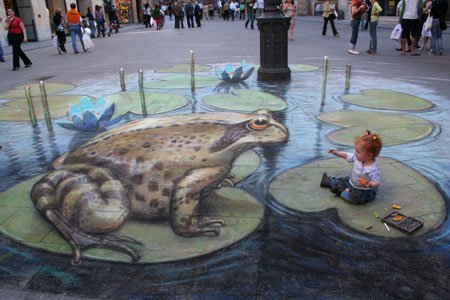 Drawn On A Flat Sidewalk With Colored Chalk.
When I bought my Blackberry I thought about the 30-year business I ran with 1800 employees, all without a cell phone that plays music, takes videos, pictures and communicates with Facebook and Twitter. I signed up under duress for Twitter and Facebook, so my seven kids, their spouses, 13 grandkids and 2 great grand kids could communicate with me in the modern way. I figured I could handle something as simple as Twitter with only 140 characters of space. That was before one of my grandkids hooked me up for Tweeter, Tweetree, Twhirl, Twitterfon, Tweetie and Twittererific Tweetdeck, Twitpix and something that sends every message to my cell phone and every other program within the texting world. My phone was beeping every three minutes with the details of everything except the bowel movements of the entire next generation. I am not ready to live like this. I keep my cell phone in the garage in my golf bag. The kids bought me a GPS for my last birthday because they say I get lost every now and then going over to the grocery store or library. I keep that in a box under my tool bench with the Blue tooth [it's red] phone I am supposed to use when I drive. I wore it once and was standing in line at Barnes and Noble talking to my wife and everyone in the nearest 50 yards was glaring at me. I had to take my hearing aid out to use it, and I got a little loud. I mean the GPS looked pretty smart on my dash board, but the lady inside that gadget was the most annoying, rudest person I had run into in a long time. Every 10 minutes, she would sarcastically say, "Re-calc-u-lating." You would think that she could be nicer. It was like she could barely tolerate me. She would let go with a deep sigh and then tell me to make a U-turn at the next light. Then if I made a right turn instead. Well, it was not a good relationship. When I get really lost now, I call my wife and tell her the name of the cross streets and while she is starting to develop the same tone as Gypsy, the GPS lady, at least she loves me. To be perfectly frank, I am still trying to learn how to use the cordless phones in our house. We have had them for 4 years, but I still haven't figured out how I can lose three phones all at once and have run around digging under chair cushions and checking bathrooms and the dirty laundry baskets when the phone rings. The world is just getting too complex for me. They even mess me up every time I go to the grocery store. You would think they could settle on something themselves but this sudden "Paper or Plastic?" every time I check out just knocks me for a loop. I bought some of those cloth reusable bags to avoid looking confused, but I never remember to take them in with me. Now I toss it back to them. When they ask me, "Paper or Plastic?" I just say, "Doesn't matter to me. I am bi-sacksual." Then it's their turn to stare at me with a blank look. I was recently asked if I tweet. I answered, No, but I do toot a lot." P.S. I know some of you are not over 50. I sent it to you to allow you to forward it to those who are.
Once upon a time, a Prince asked a beautiful Princess... "Will you marry me?" The Princess said "NO!" And the Prince lived happily ever after and rode motorcycles and went fishing and hunting and played golf and dated women half his age and drank beer and scotch and had tons of money in the bank and left the toilet seat up .
A Redneck Dog House
|
|
|

